#tsuru japan festival
Explore tagged Tumblr posts
Text







Three birds being a menace

Jailed
#lobotomy corporation#my cosplay#punishing bird cosplay#big bird cosplay#judgment bird cosplay#lobotomy corporation cosplay#lc sephirah cosplay#who let punishing bird dual wield#lobotomy corporation gijinka#abno gijinka#punishing bird gijinka#judgment bird gijinka#big bird gijinka#i love con photos so much help#tsuru japan festival#it was a wild day#faust lcb cosplay#birds didn't even know that someone was taking that first picture#most of this was unstaged#thank you for great con everyone#love ya
82 notes
·
View notes
Note
Been a while (I think?) but, do you often or sometimes listen to j-rock/band music on Spotify if you feel bored?
Ex.: Alice Schach & the Magic Orchestra, pitcher56, any CHAINSAW MAN related rock OSTs, etc.,
/genq
To my knowledge, I haven't gotten into much j-rock. I do sometimes listen to modern Japanese music. Listened to BABYMETAL during its earlier years, though only out of curiosity.
youtube
The only j-rock song I can think of is Senbonzakura or "One Thousand Cherry Trees", a vocaloid song about Japan's westernization and militarization during the Meiji restoration and Taisho Era.
(From here, I infodump about the song's intricacies and go over other Japanese songs I enjoy. Couldn't help myself. Keep reading for my analyses and overviews!)
The song's actually pretty fascinating. It uses a lot of idioms and indirect meaning, typical for older-styled Japanese songs. The idioms include references to weaponry, religion, and period imagery.
The song's visuals use an over-the-top pop portrayal of the time periods. To simplify, the time had a mix of Japanese tradition and western sensibility.

Miku's outfit is based on a army uniform but includes furisode kimono sleeves, a miniskirt, and shoes that combine loafers with geta sandals. Really leaning into the song's historical and anachronistic themes.
All of these aspects have caused some localization problems. Some English translators have put in a pro-war message that isn't explicitly stated. I will say, war propaganda songs then were incredibly subtle at the time, more than Senbonzakura. Both because that was the style at the time and probably to have more effective propaganda.
I'd say, one should expect anything made in modern Japan to be anti-war. They generally don't want a repeat of WWII.
-
Other Vocaloid Songs I Listen To
youtube
"Ah, It's a Wonderful Cat Life" is just a cute song about two cats in love. The boy cat wants the girl to join his life as a stray. The girl, however, is a house cat and doesn't want to leave her pamper life or her owner. Both yet still want to be together. This one is just nostalgic, grew up loving this one.
youtube
"The Tailor of Enbizaka" is about a kimono tailor who kills a man's family out of a jealous delusion that he's her lover. Like Senbonzakura, the lyrics never states this explicitly but the tone and visuals make it obvious.
Fun fact: The red, green, and black pattern on the side is based on kabuki curtains.

youtube
"Feathers Across the Seasons" follows an old folktale called Tsuru no Ongaeshi or "Crane's Return of a Favor".
On a snowy mountain lives a happy couple. The man eventually becomes ill, leaving the woman to provide for both and earn money for medicine. The woman is hinted to actually be a shapeshifting crane that the man once saved. She then returned to him as a woman to marry him. As favor for saving her, the wife weaves and sell cloth made of her own feathers, sacrificing her own wellbeing for her husband's life. It's implied the husband dies, leaving the crane wife a grieving widow.
Some think the wife also dies, after using her last feather. I don't think that's the case though. But, like poetry, it's inappropriate to reference death directly, so without visuals, both deaths are ambiguous.
-
Other Japanese Songs
youtube
Easy Breezy by Chelmico. I just heard the song from the anime Keep Your Hands Off Eizouken! It's a fun song about creating and having fun regardless of what other people will think of you. Very appropriate for Eizouken, funny considering I don't think it was made for the show.
youtube
Nippon Egao Hyakkei or "Hundreds of Japanese Smiles" by Momoiro Clover Z. This song is mainly based in Rakugo, a traditional form of comedy. A single storyteller tells a long tale to build up to a big punchline. These stories rely on wordplay and delivery, so it's a bit hard to get into without a innate understanding of Japanese. The music video also uses elements of kabuki and festivals.
It has a simple message of enjoyment, to just laugh regardless of what strife comes along your way.
Through these songs, I realized that there's a common sentiment to enjoy life regardless of social expectations.
-
Pacfiic Overtures
youtube
I wouldn't be me if I didn't mention Pacific Overtures. This musical is American-made. But it's based in Japan before the Arrival of the Black Ships and then before the Meiji Restoration. The original production is styled mainly after kabuki with a gradual westernization in visuals and instrumentation.
Pretty much every song here is great, my top three being The Advantages of Floating in the Middle of the Sea (the song above), There is No Other Way, and Someone in a Tree.
youtube
youtube
I recommend watching the original version then the 2003 Japanese prodution. That one removed the explicit kabuki elements, opting to use the more subtle parts of Japanese culture with a modern taste. (Using the 2004 Broadway revival since that was based on the Japanese one.)

-
As you can tell, I prefer songs based on traditional music and history, something a little more that I can sink my teeth into. Also musicals but that's a topic for another day. Sorry for rambling, had to take the opportunity.
#thanks for the ask!#ask me stuff#ask me questions#ask me anything#ask#pacific overtures#stephen sondheim#traditional japan#japan facts#senbonzakura#vocaloid#hatsune miku#ah it's a wonderful cat life#gumi megpoid#kagamine rin#kagamine len#tailor of enbizaka#megurine luka#easy breezy
6 notes
·
View notes
Text

Happy birthday Kiku! 9/9 is her birthday because it's also Japan's annual Chrysanthemum Festival. Cute right, called Kiku no Sekku or Choyo but in reality like many aspects of Japanese culture it migrated out from an earlier Chinese practice. Make no mistake, we're not talking some "National Asparagus Day" type observance, this is something with a fair amount of history behind it. Comes from old numerology beliefs about "double odd" days justifying a cycle of holidays. New Year for 1/1, Spring Festival for 3/3, makes the ninth day of the ninth month your harvest festival.
Obviously like any observance its changed over the centuries but I bet the traditional chrysanthemum sake still tastes sweet. Mum tea is quite good. Check out the kimono made of the flowers! I'm honestly learning a lot more about the festival this year myself, it's a cool fixture of annual displays.
Gotta wonder if that extends to Wano. Would Okiku like or dislike a birthday on a major holiday? It's funny to think of all the bars in Bakura Town like, trying to compete with each other over who'll attract her as a celebrity endorsement. Or much more adorably, the guys using the festival as an excuse to make a little fuss over her without Kiku getting prickly about it. If there's never any other backstory given, I'm making a headcanon now. The iconic yellow mum pattern kimono was something they always had around and made her wear for the festivities. That's why Hitetsu/Tsuru knew to salvage it for safe keeping. I'd err on the side of liking the association, it's a day everyone expects her to be flowery and girly. And our girl is nothing if not willing to live up to social expectations.
11 notes
·
View notes
Text
[Relacja] Tsuru Japan Festival 2019

23 listopada 2019 r. w Rybniku rozpoczęła się szósta edycja Tsuru Japan Festival. Impreza trwała przez dwa bardzo napięte dni, w których mało kto narzekał na nudę. Redakcja Gintama Polska miała przyjemność gościć na tym wydarzeniu, a w niniejszej relacji postaram się w miarę dokładnie pokazać, jak wyglądała zabawa na tym konwencie. Zapraszam do czytania!
Członkowie redakcji Gintama Polska gościli na Tsuru już kilka edycji temu. Tym razem, z racji tego, że przybyliśmy jako oficjalna reprezentacja, konieczne jest zrobienie krótkiego wprowadzenia do całej relacji. Weterani rybnickich konwentów mogą sobie odpuścić kolejną sekcję, ale i tak zalecamy rzucić okiem - w końcu zawsze mogę coś przekłamać!
How to: Tsuru
Głównym miejscem imprezy był Zespół Szkół Technicznych nr 1 im. Stanisława Staszica w Rybniku. To właśnie w budynku tej szkoły zostały rozlokowane wszystkie sleeproomy, sale prelekcyjne, główna scena, szatnie, wystawcy, a nawet strefa gastro. Okolica była również całkiem malownicza - w pobliżu znajdował się dosyć obszerny plac zabaw, idealny na szkolną sesję, a także Bazylika Świętego Antoniego (bardzo imponująca budowla, która z pewnością znalazła się w wielu galeriach, ale obecność konwentowiczów raczej nie była tam mile widziana). Odniosłem wrażenie, że lokalizacja była całkiem korzystna dla sesji zdjęciowych - co chwila można było zauważyć fotografów, którzy pracowali w pocie czoła z konwentowiczami w celu uzyskania jak najlepszych zdjęć.
Przyznam lojalnie, że budynek szkoły jest znacznie trudniej opisać. Po pierwsze - Zespół Szkół Technicznych nr 1 jest ogromny. Zaryzykuję stwierdzenie, że jest to aktualnie największa i najlepiej przystosowana lokacja do organizacji konwentu w całym Rybniku. Na potrzeby odwiedzających organizator wynajął dużą salę gimnastyczną, a także trzy piętra z parterem. Podejrzewam, że częściowo została wynajęta również piwnica, bo przecież helperzy-wolontariusze również muszą mieć miejsce dla siebie (a na informatorze próżno było szukać wydzielonej sali). Organizator podzielił szkołę w następujący sposób:
Skrzydło wschodnie - akredytacja uczestników + sleepy (zwyczajne, vipowskie, medialne, wystawców).
Skrzydło wschodnie - sale panelowe i wystawcy.
Środek - strefy wymagające dużego metrażu (stoiska, gastro, konsole).
Oczywiście, znalazło się sporo wyjątków od tej reguły, gdyż tak naprawdę jedyną stałą zasadą było dobrze wykorzystać 100% wynajętej przestrzeni. Tak czy inaczej, każdemu, kto zastanawia się nad wzięciem udziału w Aiconie, Mochiconie, bądź Tsuru 2020 zalecamy poświęcić trochę czasu na zaznajomienie się ze budynkiem szkoły! To znacząco ułatwia późniejsze konwentowanie :)
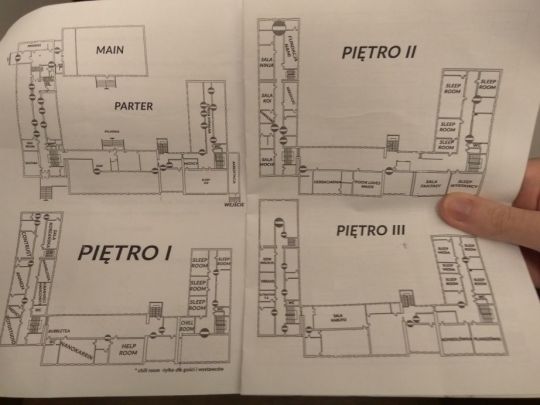
W kolejce po szczęście
Pogoda na Tsuru była świetna. Owszem, było zimno - w końcu, czego innego można spodziewać się po polskim listopadzie. Niemniej, nie było siarczystego mrozu, co skutecznie sprowokowało cosplayerów do wzięcia udziału w sesjach plenerowych. Było to również nieco pocieszające dla wszystkich uczestników, którzy mieli nieprzyjemność stać w kolejkonie. Takich osób było naprawdę bardzo dużo - dwie godziny po rozpoczęciu akredytacji ogólnej w sobotę szkoła wydawała się pełna, chociaż do całkowitego rozładowania kolejek trzeba było poczekać aż do okolic godziny 14! Organizatorzy starali się jak to tylko możliwe, aby przyśpieszyć żmudny proces wydawania wejściówek - przy kolejkach obecni byli helperzy, którzy umilali czekanie, a także instruowali uczestników, do jakich kolejek mają się ustawić. Zdecydowanie łatwiej miały osoby z wejściówkami VIP oraz goście specjalni, wystawcy, media, dla których to została przygotowana osobna kolejka w skrzydle zachodnim.
Tuż po akredytacji uczestnicy zobligowani byli do pozostawienia przedmiotów uznanych za niebezpieczne w depozycie. Na tej liście znajdowały się szklane butelki, ostre przedmioty, aerozole, itp. Przykładem rzeczy zakazanych może być bez wątpienia nóż, gaz pieprzowy, butelka po piwie. Jednak do tej samej kategorii wpadały również perfumy, dezodoranty i nożyczki. O ile zwyczajny uczestnik imprezy mógł obejść się bez tych ostatnich, to dla cosplayerów zostawienie zestawów naprawczych było nie lada wyzwaniem (to akurat rozwiązano sprawnie, ale o tym później!). Bardziej dotkliwe było utrudnienie konwentowiczom możliwości odświeżenia się. Nie chcę wysuwać daleko idących wniosków, ale dosyć specyficzny zapaszek w niedzielę po południu mógł po części być spowodowany właśnie przez to (albo nie). W każdym razie dobrze było widzieć, jak uprzejmi panowie z ochrony realizują cele postawione przez organizatora. Nie oszukujmy się - zasady te były podyktowane troską o bezpieczeństwo uczestników, co należy bez wątpienia chwalić.
Czysto i schludnie, z wyjątkami
Kwestie higieniczne na konwencie zostały zorganizowane całkiem nieźle, jak na warunki przepełnionej szkoły. Do dyspozycji uczestników zostały oddane prysznice i łazienki na każdym piętrze. Stan łazienek różnił się w zależności od wielu czynników, a sytuacja sama w sobie była bardzo dynamiczna. W praktyce oznaczało to, że zdarzały się toalety wymagające natychmiastowej reakcji jak i te całkowicie higieniczne, ale w toku trwania imprezy stan ten ulegał na zmianę poprawie i pogorszeniu. Widać było, że helperzy podejmują wysiłki w celu utrzymania czystości i chwała im za to. Nawet w niedzielę możliwe było zauważenie papieru toaletowego i mydła w łazienkach, co z pewnością dobrze świadczy o organizacji imprezy. Sale panelowe, korytarze, a nawet strefa main były czyszczone na bieżąco. Bardzo często można było spotkać helperów krzątających się między uczestnikami z workami na śmieci. Trzeba również przyznać, że konwentowicze nie utrudniali życia wolontariuszom i zabawa przebiegała bardzo spokojnie aż do niedzielnego zakończenia.
Warto również dodać parę konwentowych ciekawostek:
Na terenie imprezy działało biuro rzeczy znalezionych umiejscowione w pokoju organizatorów.
Korytarz na parterze prowadzący do sali main został przyozdobiony w tematyczne dekoracje (zapraszamy do galerii!).
Na potrzeby cosplayerów została oddana specjalna szatnia z zamkniętą toaletą. Co więcej, w pobliżu znajdowała się stacja szybkiego reagowania gdzie ekipa wyposażona w maszyny do szycia Łucznika (i nie tylko) oferowała swoją pomoc w poprawie, bądź nagłym ratowaniu stroju. To właśnie z tego powodu cosplayerzy nie mieli powodów do zmartwień po zostawieniu zestawów naprawczych w depozycie.
Na konwencie panował całkowity zakaz używania wysokonapięciowych urządzeń elektrycznych (np. czajników do gotowania wody). Organizator poinformował o tym uczestników z odpowiednim wyprzedzeniem.
Wystawcy i jedzenie
Stoiska i stragany wszelkiej maści wystawców zajmowały najwięcej przestrzeni na całym konwencie. Trzeba również pogratulować organizatorowi doskonałego wykorzystania metrażu w budynku szkoły. Otóż aby dostać się ze sleepa (skrzydło wschodnie) na sale prelekcyjne albo główną scenę (skrzydło zachodnie) należało przejść przez któryś z korytarzy wewnątrz budynku. To właśnie na tych ogromnych korytarzach rozlokowane były stoły z podkładkami, artami, kubkami, dosłownie wszystkim, co tylko można znaleźć na konwencie. Na tych samych korytarzach znajdowała się również strefa gastronomiczna, w której można było bez cienia wątpliwości, wyjątkowo dobrze zjeść. Oferta kulinarna przygotowana przez organizatorów była bardzo bogata, a zapachy dochodzące z sal wabiły uczestników do środka. Nawet najwytrwalsi konwentowicze ulegali instynktom drugiego dnia konwentu. Oczywiście, oprócz tego w samym Rybniku też dało się dobrze zjeść - w okolicy znajdowało się kilka ciekawych pizzerii, a tuż po wyjściu ze szkoły w swoje zielone progi zapraszała Żabka.
Artyści, rękodzielnicy i cosplayerzy mieli do dyspozycji swój własny korytarz w zachodnim skrzydle. To właśnie tam dziewczyny z naszej grupy zaopatrzyły się w śmieszne przypinki, a także figurki postaci z Gintamy, których zdjęcia możemy podziwiać w naszej galerii!
Goście, atrakcje, wydarzenia
Podczas tegorocznej edycji Tsuru była możliwość wzięcia udziału w wielu ciekawych panelach tematycznych przygotowywanych przez zaproszonych gości. Organizator zaprosił na konwent ludzi związanych z szeroko rozumianą kulturą dalekowschodnią. Wśród tych osób można było znaleźć znane i lubiane twarze z serwisu YouTube, autorów książek, czy nawet japońskich artystów! Właściwie od rozpoczęcia sobotniej akredytacji, aż do zamknięcia konwentu w niedzielę cały czas coś się działo. Uczestnicy mieli możliwość posłuchać o wielu ciekawostkach związanych z Japonią i nie tylko z opowieści osób, które tam były. Jeśli kogoś nie interesowały takie tematy albo po prostu był już nimi zmęczony, zostały przewidziane panele o tematyce typowo rozrywkowej. Konkursy, pogadanki o anime, grach komputerowych, warsztaty rysowania - to wszystko i więcej prowadzone przez ekipy medialne, bądź niezależnych twórców atrakcji. Mimo wszystko trzeba przyznać, że można było odczuć mały niedosyt. Mnóstwo zaproszonych gości oznaczało mnóstwo paneli o danej tematyce, co praktycznie zdominowało cały program atrakcji i mogło znudzić zwolenników typowych paneli o popkulturze.
Dla konwentowiczów zostały udostępnione salki z grami planszowymi. Na parterze rozstawiono maty do DDR, pojawił się również gamesroom. Na głównej scenie tańczyły idolki, można było uczestniczyć w koncercie na shamisenie, a także załapać się na Kobito Rakugo. Główna sala nie była tak imponująca, jak na innych konwentach, ale w większości przypadków była wystarczająca (wyjątkiem był konkurs cosplay, na którym wielu widzów musiało oglądać występy z korytarza).
Konwent dla cosplayerów
Tsuru Japan Festival 2019 był z całą pewnością gratką dla cosplayerów (zarówno tych doświadczonych, jak i stawiających pierwsze kroki) i ludzi związanych z tym światem. Powodów było mnóstwo, a część z nich zaczęła się pojawiać jeszcze podczas promocji wydarzenia w sieci. W naszych mediach i na naszej stronie wciąż wiszą informacje o gościach-cosplayerach, którzy zostali zaproszeni do wzięcia udziału w konwencie. Niektóre postaci prowadziły atrakcje tematyczne ze swoich specjalności dla każdego, kto odważył się na nie przyjść. Inne osobistości były zaangażowane w konkurs cosplay jako jury. Ponadto, pojawiło się wiele znanych i lubianych twarzy z Czech, które na specjalne zaproszenie organizatora pojawiły się na konwencie w Rybniku. Była to doskonała możliwość dla wszystkich fanów z Polski, aby porozmawiać i zrobić sobie parę zdjęć. Kostiumy, w jakich pojawiła się czeska delegacja, robiły nie lada wrażenie, co zresztą dało się zauważyć w wielu pokonwentowych galeriach (w naszej też!).
Cosplayerzy z Czech przyjechali głównie w celach rozrywkowych, ale część z nich zdecydowała się na udział w konkursie cosplay. Rywalizacja była niezwykle zacięta, ale organizator przewidział taki rozwój wydarzeń i odpowiednio wcześnie podjął kroki w celu przygotowania większej puli nagród. Oprócz upominków rzeczowych za miejsca na podium, do których przyzwyczaiły nas inne polskie konwenty, stawką w grze były również wejściówki na inne imprezy organizowane przez partnerów Tsuru. Przyznam szczerze, że jest to dosyć ciekawy ruch i świetny powód do wyrwania się ze swojej lokalnej strefy konwentowej! Rozdawano zaproszenia na czeskie konwenty Advik, Animefest, Comic-Con, a także łódzki Wielki Bal Cosplayowy. Wyglądało na to, że wygrani cieszyli się z wyróżnień i nagród, dowodem czego może być fakt, że po konkursie nie było żadnej spektakularnej “dramy” :) Na pochwałę zasługuje gest ze strony organizatora - każdy uczestnik konkursu otrzymał pamiątkowy medal za uczestnictwo. Dzięki temu nikt ze sceny nie zszedł przegrany!
Podsumowanie
Tsuru Japan Festival 2019 był konwentem o bardzo wysokim poziomie i zdecydowanym must-see na fandomowej mapie Polski. Każdemu, kto jeszcze nie miał okazji, zdecydowanie polecam wzięcie udziału w którymś z rybnickich konwentów. Podejrzewam, że zarówno za jesienną edycją, jak i wiosenną i letnią stoi ten sam zespół organizatorów, który bez wątpienia wykonał dobrą robotę tej jesieni. Impreza, w której miałem przyjemność uczestniczyć to były dwa bardzo napięte dni, podczas których działo się naprawdę wiele. Dni pełne atrakcji, humoru i niesamowitych ludzi. Niestety, nie obyło się bez drobnych wpadek i minusów - sfera higieniczna zawsze mogła być lepsza, conplace był ewidentnie przepełniony, a atrakcje zdominowane przez gości. Konwent sprawiał wrażenie idealnego miejsca dla cosplayerów, ale co z resztą uczestników, którzy nie są zainteresowani tą zabawą?
Podejrzewam, że wiele problemów rybnickich konwentów rozwiązałoby się samo, gdyby zaproponować inną, większą lokalizację. Ze względu na swój specyficzny układ Zespół Szkół Technicznych nr.1 był zarówno sprzymierzeńcem, jak i wrogiem organizatorów. Tsuru przyciąga swoimi atrakcjami i dobrym zorganizowaniem, ale im więcej gości tym trudniej jest ich obsłużyć na wysokim poziomie.
Po wymianie zdań z tak zwanymi “localsami” dochodzę do wniosku, że nie do końca możliwe jest znalezienie w Rybniku lokalizacji, która lepiej nadaje się na organizację konwentu. W niektórych przypadkach zmiana miasta pomaga się rozwinąć…
...ale Tsuru znaczy Rybnik. I tak już musi być.
7/10
~rzx
1 note
·
View note
Photo


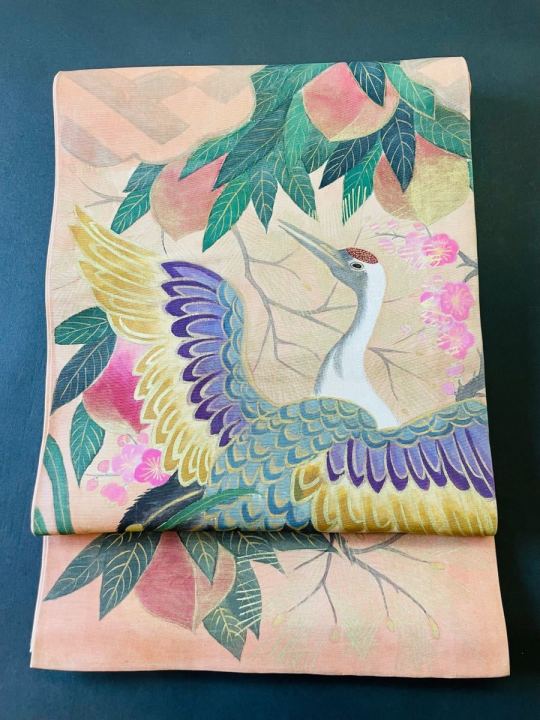
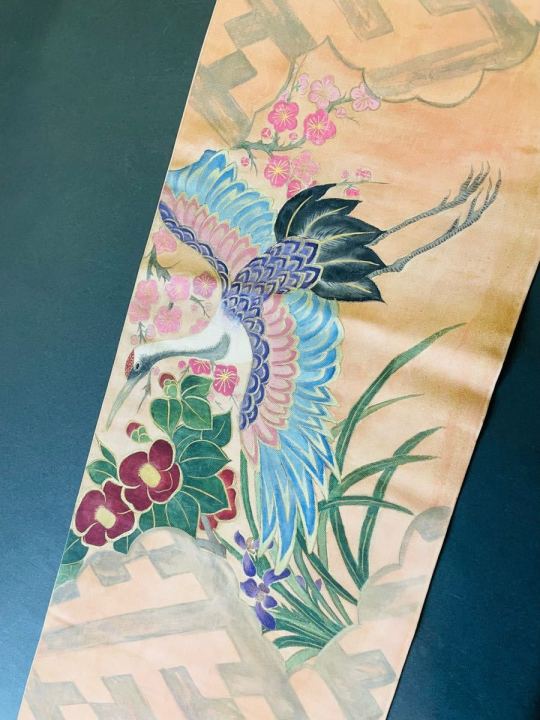

Antique double patterned obi with auspicious motifs linked to Hinamatsuri (dolls festival on the 3 of March) which was in the past known as “Peach Festival” (Momo no Sekku).
The box with painted shells set (kaioke) is an ancient Heian era game called kaiawase where players had to match shells, often hinting at Genji no monogatari scenes. It was as very precious item and often part of rich households dowry (matching shells somehow symbolizing matching spouses).
#japan#fashion#kimono#obi#doll festival#hinamatsuri#Momo no Sekku#Peach Festival#kaioke#kaiawase#heian#Genji no monogatari#shell#kai#tsuru#crane#peach#momo#着物#帯
110 notes
·
View notes
Text
DAIMAJIN STRIKES AGAIN

Daimajin is about to mete out final punishment on the evil Lord Arazawa.



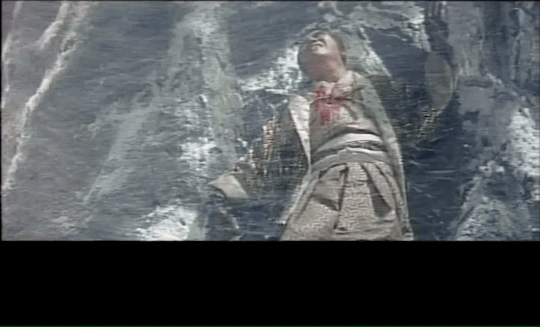
Lord Arazawa’s lifeless body sinks into the same boiling sulphur pit that he intended to throw his slave workers into.


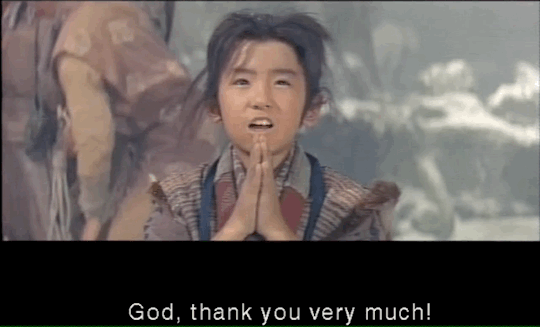
Tsuru, Sugi and Daisaku are reunited with the men from their village who were abducted by Lord Arazawa’s samurai.
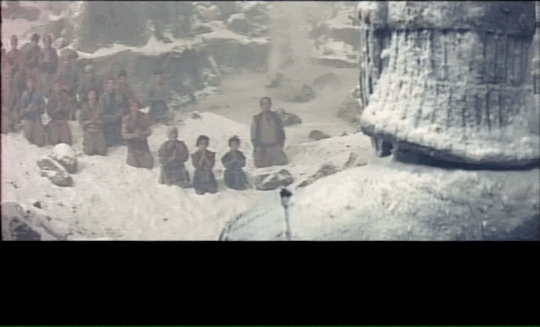
His mission accomplished, Daimajin prepares to depart.


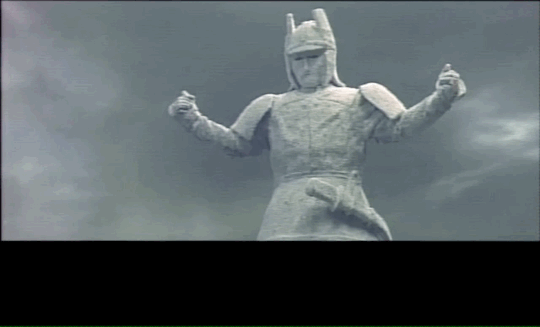


And thus we come to the end of the Daimajin trilogy, just in time to celebrate its 55th anniversary (just like Ultra Q, Ultraman, Star Trek and the Slurpee).
This was the end of Daimajin’s cinematic adventures, which is a darn shame. I’ve read several sources that state that Daimajin was originally conceived as an opponent for Gamera (whose adventures Daei Film had only recently begun producing), but it was decided to give him his own series as well. I think a Gamera/Daimajin face-off would have been hugely entertaining, but what do I know?
Daimajin did battle Godzilla, sort of, in 1992′s Godzilla Color Special from Dark Horse Comics.
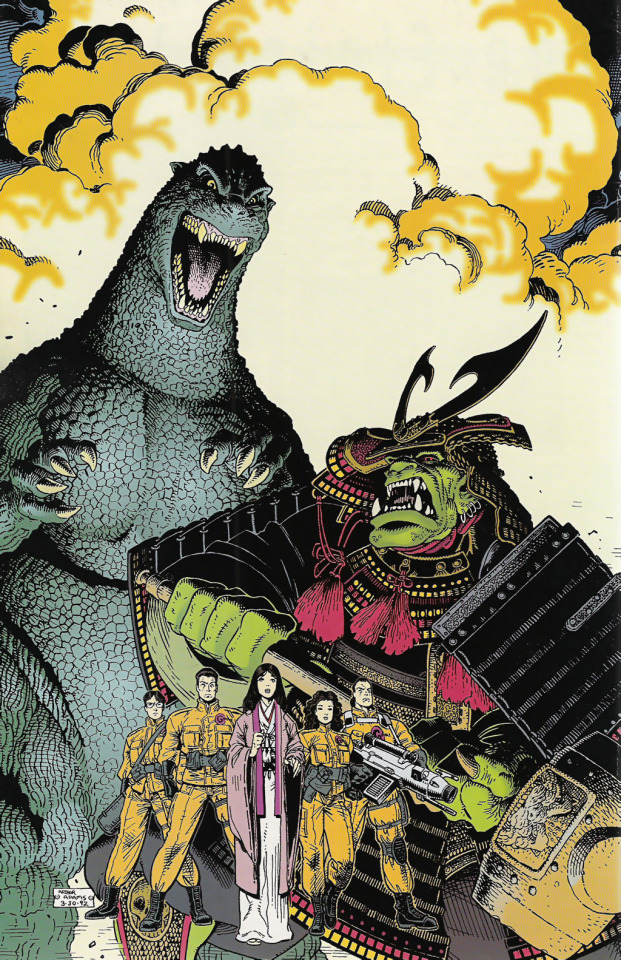
Written (with an assist from Randy Stradley) and drawn by Arthur Adams (perhaps the greatest Godzilla artist ever!), the story involves The Big G battling an oni named Genkido-Jin, a protector deity for a small island off of Japan. When Godzilla attacks the island, a man sacrifices his life in order for Genkido-Jin to come alive to battle Godzilla.
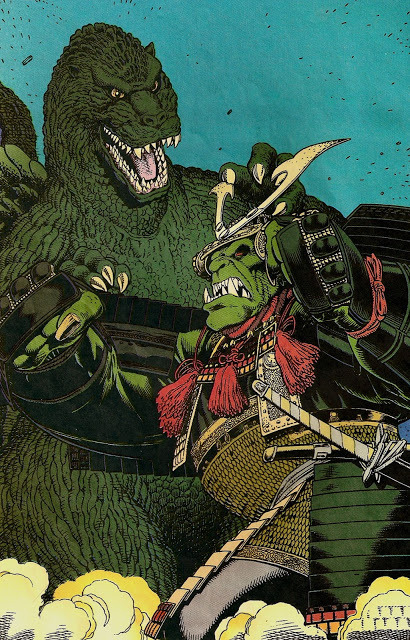
The battle is one-sided at first, with Godzilla’s greater size and atomic breath making short work of the oni. But Genkido-Jin keeps reforming, bigger each time, until he and Godzilla are almost equal as they battle away!
Since Dark Horse was only able to license the use of Godzilla from Toho and couldn't’ feature other cinematic kaiju with him in their comics, actually using Daimajin (especially since he is owned by a different company) was impossible. That is why Genkido-Jin is wearing samurai armor instead of keiko armor, and has a much more monstrous face. However, this is a fantastic “what if--?” story.
Art Adams is at the height of his artistic powers with this one, folks. And he also gives us the introduction of the Godzilla hunting/fighting team G-Force, a full year before Toho used the same name in the Heisei films. The comic has been reprinted in a few different trade editions, and is well worth seeking out!
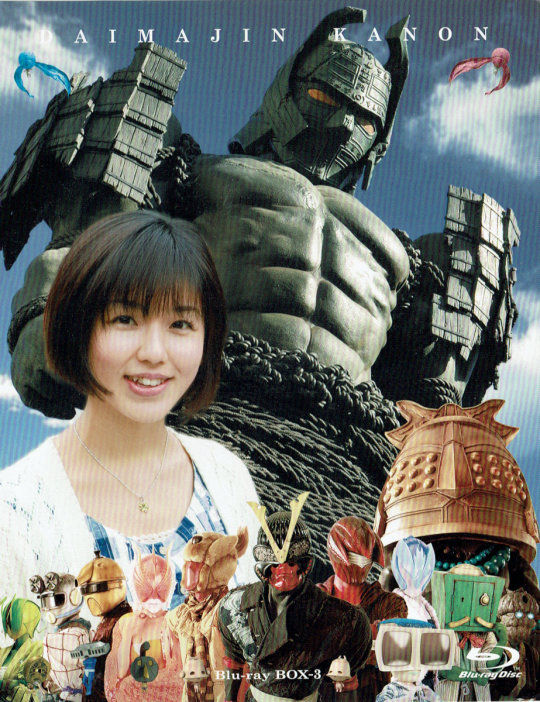
A 2010 television series, Daimajin Kanon, billed itself as a sequel of sorts to the film trilogy. However, the Daimajin in this series is actually named Bujin, and has about as much in common with the original Daimajin as the Hanna-Barbera Godzilla has with the original 1954 Godzilla.
The television series was preceded by a manga series which, though it had differences with the television version, explained some of the concepts of the new Daimajin. By itself the television show is an interesting and entertaining mash-up of yokai, kaiju, and Kamen Rider (!), and I hope to dedicate a post or three to it soon. I will say this about it, though: it features perhaps the sexiest goldfish known to man!

Finally, Daimajin returned to the big screen this year in Takashi Miike’s The Great Yokai War: Guardians (which itself is a sequel to his 2005 film The Great Yokai War).

The film premiered in Japan earlier this month, and it closes out this year’s Fantasia Film Festival on Wednesday, Aug 25. The official US premiere is Saturday, August 28, in New York City at the Japan Society.
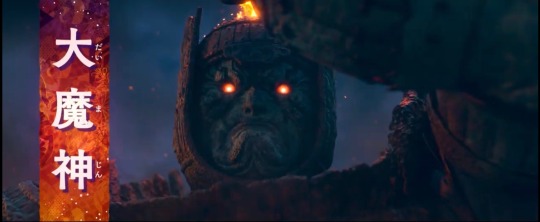
I have no idea when - or if - the film is going to be shown near me here in the Los Angeles area. Frankly, as the delta variant rages and hospitalizations are going up even among fully vaccinated people, I am not comfortable returning to movie theaters yet. I am quite fine with waiting to watch this film at home when the opportunity arises.
I certainly hope it’s as good as the 2005 film. This and Shin Ultraman are the only two films coming out this year that I’ve really been excited about!
#Daimajin Strikes Again#Daimajin#Daimajin Kanon#Godzilla Color Special#Arthur Adams#Art Adams#Genkido-Jin#Dark Horse Comics#The Great Yokai War: Guardians#kaiju#samurai#tokusatsu#Daei Film#Takashi Miike
44 notes
·
View notes
Text
The Blossom and the Sword (日本侠花伝) 1973 dir. Tai Kato

status: completed download here
**translation notes:**
・A word about the film title in Japanese: the main title is “Nihon Kyoka-den”(日本侠花伝), which, roughly translated, means “A Japanese Legend of Chivalry and Flowers”. Other films centered around yakuza often featured the kanji for “chivalry” used here, “俠”. Interestingly, although it is only ever alluded to on posters and advertisements, the film is actually made up of 2 parts, titled as follows: “Part 1: Japanese Thistle”(第一部 野あざみ), “Part 2: Blue Peony”(第二部 青い牡丹).
・The “e-toki” books that Mine sells on the train in the beginning of the film are picture books that have illustrated depictions of notable Buddhist tales and figures, for use in educating people about Buddhism. The history of e-toki is a long and complicated one: as the tales depicted within were often “performed” with musical accompaniment, these performances gradually began to be viewed as their own art form akin to theatre, though usually performed by female beggar nuns. From the 12th to roughly 18th century, these “nuns” essentially became prostitutes, but from the 18th century onwards their presence in brothels waned, and those that went around peddling e-toki were generally lowly females trying to scrape together a living.
・The Seiyukai was one of the main political parties active during the period in Japan depicted in the film. It is considered a conservative/right-wing political party by modern definitions. The opposing political party, as mentioned in the film, was the slightly more liberal Kenseikai.
・The “tokko” police, or Special Higher Police, was a sector of the Japanese police force in the early 20th century that dealt with high policing and political-driven criminal investigations. They were also thought of as the “Thought Police”.
・The silent film being shown at the cinema in the film is “Play Safe” (or its two-reel version “Chasing Choo Choos” which only features the train chase), which was released in 1927. This is odd, because the period of time depicted in The Blossom and the Sword is approximately 1915 to 1918. The film is being narrated by a benshi, a traditional Japanese narrator that would “perform” dialogue and narration from films throughout the Taisho era. Most Japanese films made during the era of the benshi were made with them in mind, but in the case of Western films like this one, it was likely that the benshi just made up the story as they went along (the names of the characters have been changed).
・The song Tsuru sings as she walks home with Mine from the hostess bar is “Hito wo Koiuru Uta”(人を恋うる歌), a famous Taisho-era ballad. It was written by Tekkan Yosano, well-known Japanese poet Akiko Yosano’s husband.
・A “lined kimono”, as the name suggests, is a thicker kimono with inner lining. The reason Mine says “You’re still wearing your lined kimono!” is probably because at that point, although summer has arrived (as mentioned by Tsuru in the bar earlier), all Minoru does is lay about in their apartment.
・ The Ushi-oni Festival is a traditional festival held at Uwajima, Ehime, and features bullfighting, parades, and fireworks.
・The song Kinzo starts singing after rescuing Mine and Minoru is from a bunraku play called “Hadesugata Onna Maiginu”(艶容女舞衣), about the trials and tribulations of a wife in feudal Japan, with themes of forbidden love and lovers’ suicide.
・The rice crisis that forms the basis of the storyline in the second half is based on real events that occurred in Japan in 1918. There have been numerous times when rice shortages have caused extreme inflation in Japanese history, but the rice riots that happened over the course of several months in 1918 is the biggest recorded rice disaster in the country’s history. Rising populations, post-WWI rice market booms, and large portions of rice reserved for troops as part of the Siberian Intervention were amongst the factors for the rice inflation in 1918, and led to city-wide riots in places like Toyama, Kobe, Kyoto and Nagoya. Japanese rice being sent overseas for the military was particularly held in disdain by impoverished citizens (i.e. farmers that would earn much less than what their own rice was being sold for), and protests at fishing ports would often lead to buildings being destroyed and general havoc. It is said that women - particularly the wives of fisherman and farmers that suffered the worst during the crisis - were at the forefront of these demonstrations, and played a big role in communicating the dissatisfaction and economic suffering of the lower class.
・There are a few references to the yakuza “code” of virtue or ethics, which, like similarly depicted in other yakuza films, is primarily concerned with a bent sort of chivalry and respect for one’s fellow man. The particular phrase “tosei no jingi” (渡世の仁義)is mentioned, which can be considered as “the rules by which a yakuza must live”. Given the amount of betrayal and underhanded tactics in this film - a representation perhaps of the dying out of the “old ways” of the yakuza at the time - every time a reference to this code is made, it is likely said with irony.
・References are made to “anko-beya”(アンコ部屋), which has been translated to “laborers quarters” - barely livable, cramped residences in which laborers (usually female - “anko” is an old word for female) live. This word also appears frequently in Nuclear Gypsies.
7 notes
·
View notes
Text
Nampō Roku, Book 2 (43): (1587) Seventh Month, Seventh Day, Beginning at the Hour of the Monkey.

43) Seventh Month, Seventh Day¹; beginning in the hour of the Monkey².
◦ 4.5-mat [room]³.
◦ [Guests:] Omuro-gosho [小室御所]⁴, Konoe dono [近衛殿]⁵, Ryōshitsu [良叱]⁶, Ryōmu [了無]⁷.
Sho [初]⁸.
﹆ In a [hanging] basket [籠], yūgao-no-hana [夕カホノ花]⁹.
◦ Small ito-me kama [絲目小釜], [suspended] on a [bamboo] jizai [自在]¹⁰.
◦ On the Sairō-dana [城樓棚]¹¹: ◦ above, habōki [羽帚]¹²; ◦ below, mizusashi tarai [水指 タライ] ・ hikkiri [引切]¹³.
Su [ス]¹⁴.
▵ Suimono [吸物]¹⁵.
▵ Two rounds of sake [酒]¹⁶.
▵ Senbei ・ iri-kaya ・ shiitake [センヘイ ・ イリカヤ ・ 椎茸]¹⁷.
Go [後]¹⁸ -- [the guests] entered [after] night[fall]¹⁹.
◦ The toko: [after] the hanaire was taken in[to the katte]²⁰, a tanzako-bako [短尺箱] was [displayed on the floor of the toko]²¹.
◦ On the Sairō-dana: ◦ above, on a tray, ﹆kōro [香爐], usu-gumo [薄雲] [in the] kōgō guri-guri [香合 クリ〰], with the kyōji [香箸] stacked on top²². ◦ middle, hishaku [ヒシヤク]²³; ◦ below, mizusashi, as in the beginning ・ futaoki, as in the beginning²⁴.
◦ Chaire ryūgo [茶入 リウコ]²⁵.
◦ Chawan Ko-mamori [茶碗 木守]²⁶.
After tea was finished, incense [was appreciated]²⁷.
_________________________
¹Shichi-gatsu nanoka [七月七日].
The date was August 10, 1587, in the Gregorian calendar.
This day was also the Festival of Tanabata [七夕] (tanabata no sekku [七夕節句]: Festival of the Stars; Festival of the Weaver; and so forth), which celebrates the once-a-year meeting of the celestial deities Orihime [織姫] (the Weaver: the star Vega) and Hikoboshi [彦星] (the Cowherd: the star Altair). According to legend, the Milky Way separates these lovers, and they are allowed to meet only once a year on the Seventh Day of the Seventh Lunar Month. Tanabata is celebrated in all of the countries within the classical Chinese cultural sphere (including Korea, Japan, and Vietnam).
Because the idea is that the two stars meet across the Milky Way, it has been traditional (apparently since the time of Jōō) for the irori to be used on chakai given on this date, so that the host and the guests will be able to face each other across the ro.
²Saru-no-toki yori [申ノ時より].
There were twelve traditional hours in each day, though each was equivalent to two Western hours (i.e., 120 minutes) only on the equinoctes.
The Hour of the Monkey lasts roughly from 3:00 PM to 5:00 PM. The chakai, therefore, began in the late afternoon.
³Yojō-han [四疊半].
This would have been the 4.5-mat room in Rikyū's official residence.

⁴Omuro-gosho [小室御所].
Rikyū has made a clerical error here: the title should be written Omuro-gosho [御室御所].
Omuro-gosho [御室御所] is another name for the Ninna-ji [仁和寺], the head temple of the Omuro school of the Shingon [真言] (True Word) Sect of Buddhism. And, when used as a personal epithet, as here, it refers to the Abbot of the Ninna-ji [仁和寺], who was an Imperial Prince (a custom that persisted until the end of the Edo period).
In this case, the sobriquet refers to Ninnaji-no-miya Shurihō shinnō [仁和寺宮守理法親王; 1558 ~ ?], a son of Prince Kunisuke (Fushimi-no-miya Kunisuke shinnō [伏見宮邦輔親王; 1513 ~ 1563], who was adopted by the Emperor Ōgimachi [正親町天皇; 1517 ~ 1593]. Prince Shurihō entered the Ninna-ji in Eiroku 8 [永禄八年] (1565), as a disciple of another Imperial Prince, Ninjo nyūdō shinnō [任助入道親王; 1525 ~ 1584].
⁵Konoe dono [近衛殿].
This was Lord Konoe Sakihisa [近衛前久; 1536 ~ 1612], a high court noble (he held the junior grade of the First Rank), who served as kanpaku [関白]*, Minister of the Left (sa-daijin [左大臣]), Chancellor (daijō-daijin [太政大臣]), and, after he left that office, he was further honored as jū-san-gū [准三宮]†.
Lord Sakihisa was close to both Oda Nobunaga and Hideyoshi -- Hideyoshi adopted Sakihisa's daughter Sakiko [前子; 1575 ~ 1630], who was given by him as a consort to the Emperor Go-Yōzei; she gave birth to the Emperor’s son, who became Emperor Go-Mizunoo.
Furthermore, in 1585, Lord Sakihisa (whose family represented one of the major branches of the ancient Fujiwara house) adopted Hideyoshi himself, which gave Hideyoshi the necessary entrée to become kanpaku in his turn. __________ *Chief civil adviser to the Emperor.
†An honorary rank meaning that Lord Sakihisa was accorded honors similar to those of the Great Empress Dowager (theoretically the Emperor's grandmother), the Emperess Dowager (in theory, the Emperor's mother), and the Empress (the Emperor's principal wife). The title translates “quazi-Three Empresses.”
⁶Ryōshitsu [良叱].
This refers to Ishibashi Ryōshitsu [石橋良叱; his dates of birth and death are not known], a machi-shū of Sakai, chajin, and one of Rikyū's sons-in-law (musume-muko [娘婿], the husband of one of Rikyū's daughters).
His name first appears in an entry dated to the Tenshō 10 in the Tsuda Sōkyū Chanoyu Nikki [津田宗及茶湯日記], when Ryōshitsu participated in a chakai together with Yamanoue Sōji and Tsuda Sōkyū.
While some scholars argue that Ryōshitsu must have been one of Rikyū's disciples, the Chajin Kei-den Zenshū [茶人係傳全集], published in Tenpō 8 [天保8年] (1837), states that he was initiated into the practice of chanoyu by Jōō (which seems more likely, since it appears that Rikyū married his daughters to men of his own generation). __________ *The title translates “the Complete Collected Transmitted Lineages of the Tea Masters.”
⁷Ryōmu [了無].
Unidentified. His name is also mentioned as being one of the guests at the previous chakai (which Rikyu hosted on the bank of the Kamo-gawa in the evening of the last day of the Sixth Month, after the conclusion of the lustration known as the Minazuki-barae [水無月祓]).
⁸Sho [初].
The shoza.
In terms of kane-wari, since this chakai began in the late afternoon, and continued until well after dark, the shoza should be yang, while the goza should be yin.

- The tokonoma contained the chabana, but suspended on the minor pillar attached to the outer wall (so that it would be illuminated by the fading light entering through the bokuseki-mado [墨跡窓] -- which would not reach the chabana if it were hung in the middle of the toko), so that the toko was chō [調];
- the room had the kama in the ro, and so was han [半];
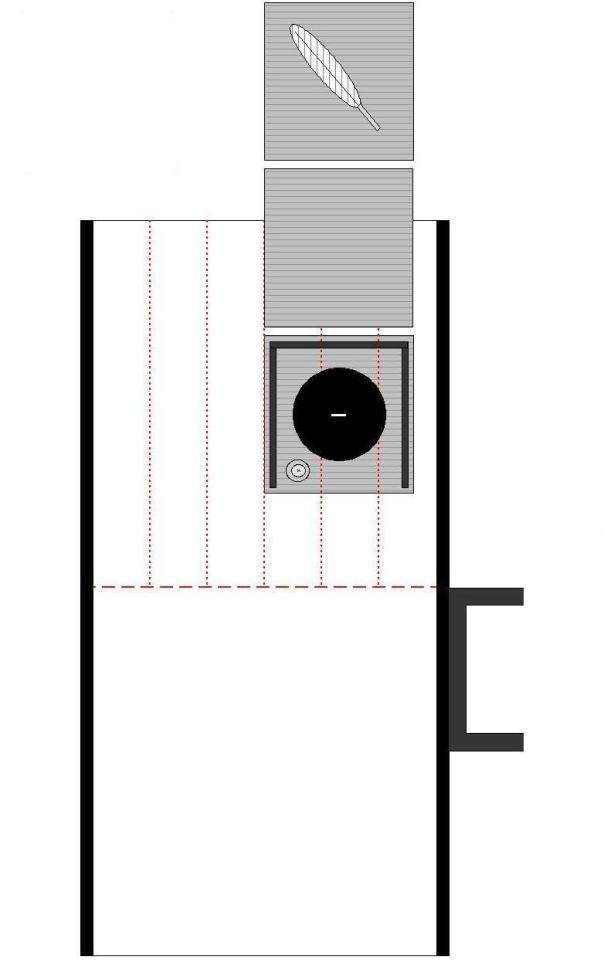
- and the tana held the haboki (on the ten-ita), and the mizusashi and futaoki (on the ji-ita), and so was chō [調].
Chō + han + chō is han.
⁹Kago ni yūgao-no-hana [籠ニ 夕カホノ花].
The kago was probably the Katsura-kawa kago [桂川籠], so that the chabana could project away from the pillar on which it was suspended, and so catch the rays of the late afternoon sun coming in through the bokuseki-mado [墨跡窓]*.

The word yūgao [夕顔] refers to the flower of the calabash, a type of elongated bottle-gourd (Lagenaria siceraria var. hispida) -- whose simple, white flowers open in the late afternoon.
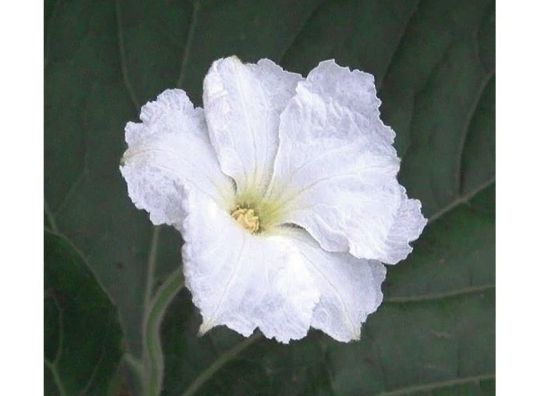
__________ *Which, in Rikyū's tearooms, was always located behind the shōkyaku's shoulder, just outside of the toko itself. The bokuseki-mado was on the west side of the room.
¹⁰Ito-me ko-gama jizai ni [絲目小釜 自在ニ].
This was another old Temmyō kama [古天妙釜], though likely repaired by Yojirō [與次郎], Rikyū's kama-shi [釜師].

It is not really such a "small kama" (it was probably made as a kiri-kake kama for use with a large kimen-buro on the o-chanoyu-dana*); but it is definitely much smaller than Jōō's large ito-me kama (which Rikyū also owned -- and used during the first three chakai documented in Book Two of the Nampō Roku).
The rather flat shape of the kama suggests that it was probably suspended low in the ro (so that the mouth was 6- or 7-bu below the level of the ro-buchi). This would have made the fire in the ro seem more distant, thus appearing “cooler” to the eyes of the guests.

The kama was suspended on a susu-dake jizai [煤竹自在] (a jizai made from a length of oil-stained bamboo, taken from the ceiling of a farmhouse kitchen), using Rikyū’s bronze kan and tsuru (above).
The word ito-me [絲目] means thread-lines. The pattern on the kama, then, can also be taken as an allusion to Orihime [織姫] (which means the Weaver-princess), one of the stars being celebrated on Tanabata. __________ *The kama was probably repaired -- with a rounded bottom -- on Rikyū's orders.
¹¹Sairō-dana [城樓棚].
This was another tana created by Tsuda Sōkyū. In this case, it was based directly on the fukuro-dana, and features the compartment for the mizusashi, the naka-dana, and (half of the) ten-ita.

I have found no photographs of this rarely seen tana. However, the Enkaku-ji does have one; and their Sairō-dana has panels on three sides of the compartment in which the mizusashi is placed (if I recall correctly, the panels have openwork, and they do not quite reach the tana above and below -- in other words, there is a roughly 1-sun wide opening above and below the panel; all three panels were the same, and, I believe, featured the design shown above, which is called a kōzama-sukashi [香挾間透])*.
According to Tanaka Senshō, this tana was created to represent the right half of the fukuro-dana. Consequently, it is supposed to be placed on the utensil mat so that it occupies its original place. When Sōkyū first made the Sairō-dana, the right side of the tana was placed on top of the right heri (just as Jōō said the fukuro-dana should be oriented†); but by the time of this chakai, since the fukuro-dana was now being centered on the utensil mat (at Hideyoshi’s behest), so this tana, too, is placed so that the left side touches the central kane‡. ___________ *While this does not match the way things are done today (even, it seems, by the Nampō-ryū), Kanshū o-shō-sama once told me that, if it is difficult to dip the water from the mizusashi if it is in the middle of the ji-ita (on account of the shape or size of the mizusashi), then the mizusashi should be lifted forward (so that the front edge of the foot is near the front of the shelf -- the way the mizusashi is moved forward when using the Jōō-dana [紹鷗棚]) -- as below.
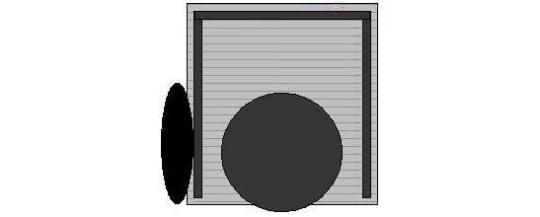
Furthermore (and not only if the mizusashi is moved forward), he added that if it is difficult to lean the lid of the mizusashi against its left side, then the lid should be leaned against the left side of the tana, as shown above.
†This was done so that the mizusashi would occupy the same spot that it would if it were resting on the shin-daisu -- which was the only way chanoyu had been performed before then. (The fukuro-dana represented the first departure from the tea of the daisu, and so Jōō was still constrained by its teachings.)
‡Nowadays this teaching, too, seems to have been forgotten. Even in the Enkaku-ji, the tana is centered in the middle of the mat when used with the ro.
¹²Ue habōki [上 羽帚].
The habōki -- made from feathers between 9-sun and 1-shaku long -- was placed on the ten-ita of the Sairō-dana. It is not possible to speculate on the kind of feathers that would have been used.

The naka-dana was left empty during the shoza.
¹³Shita mizusashi tarai ・ hikkiri [下 水指 タライ ・ 引切].
This mizusashi was mentioned before in Book Two of the Nampō Roku, in the description of the chakai that Rikyū hosted on the 17th day of the Eleventh Month. In that entry, the mizusashi is referred to as a hando [ハント] (meaning a handō [飯胴], a sort of bronze container in which rice was served in a temple).
According to Book Six of the Nampō Roku, Rikyū owned two such containers, which he used as mizusashi, in succession. The first was 1-shaku 5-bu by 7-sun 5-bu, and had large round kan on the left and right sides. But he gave (or sold) this mizusashi to the daimyō Arima Noriyori [有馬則頼; 1533 ~ 1602]. Rikyū subsequently acquired a second container (which he calls a tarai [タライ = 盥], which means a basin such as used when washing the hands). This second container was round, and 8-sun in diameter. It also lacked handles. The color of this second container (according to the passage in Book Six of the Nampō Roku) was even more splendid than [the first].

The first-mentioned piece was too large to be placed on the Sairō-dana. Thus it must have been the second mizusashi that Rikyū used on this occasion. (The actual piece has not been identified; the photo, above, is of a similar kind of sawari mizusashi.)
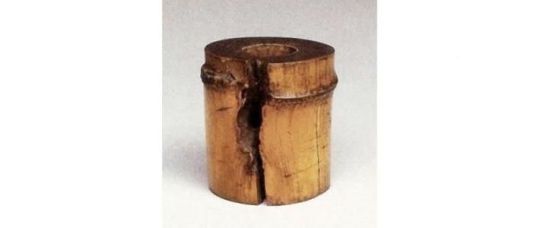
Hikkiri [引切] refers to the futaoki -- one of Rikyū's take-wa [竹輪].
¹⁴Su [ス].
The section introduced by the word su [ス]* usually refers to utensils brought out from the katte at the beginning of the sumi-temae.
However, here it is curiously followed by the menu of the abbreviated kaiseki. __________ *Which is shorthand for the kanji mata [又], meaning “and again.”
¹⁵Suimono [吸物].
Suimono [吸物] means a clear soup, usually with small pieces of food included*.
Because Tanabata was a national holiday, the shōkyaku and ji-kyaku (if not the others†) would have had their fill of rich food over the course of the day at the Imperial court. __________ *Unlike nimono [煮物], here it is the soup that forms the bulk of the dish, with the solid food (sometimes just a couple of leaves, or mushrooms) added as a sort of garnish.
†The other two guests (who seem to have been among Rikyū's intimates) may have been charged with taking on the role of attendants, arranged by Rikyū to assist the two noblemen who occupied the first two places among the guests.
¹⁶Sake ni kaeshi [酒二返].
Two rounds of sake were served. The host usually joined his guests in drinking.
¹⁷Senbei ・ iri-kaya ・ shiitake [センヘイ ・ イリカヤ ・ 椎茸].
These were the kashi.
Senbei [煎餅] are rice crackers. Since they were a common gift given by the guests to the host, perhaps one of the noblemen had brought a box of fine senbei to Rikyū -- who decided to share them with everyone.
Iri-kaya [煎り榧] are the roasted nuts of the Japanese allspice tree (which is also known as the Japanese nutmeg yew, Torreya nucifera).
And the shiitake [椎茸] were most likely also roasted, on skewers, over a charcoal fire, dusted lightly with crushed salt as they were cooking.
¹⁸Go [後].
The goza.
With respect to the kane-wari:
- the toko had a tanzaku-bako [短冊箱] displayed on the floor, with a tankei [短檠] (a wooden stand supporting an oil-lamp) off to one side (the side closest to the toko-bashira)*, making it chō [調];

- the room had the kama in the ro, making it also han [半];
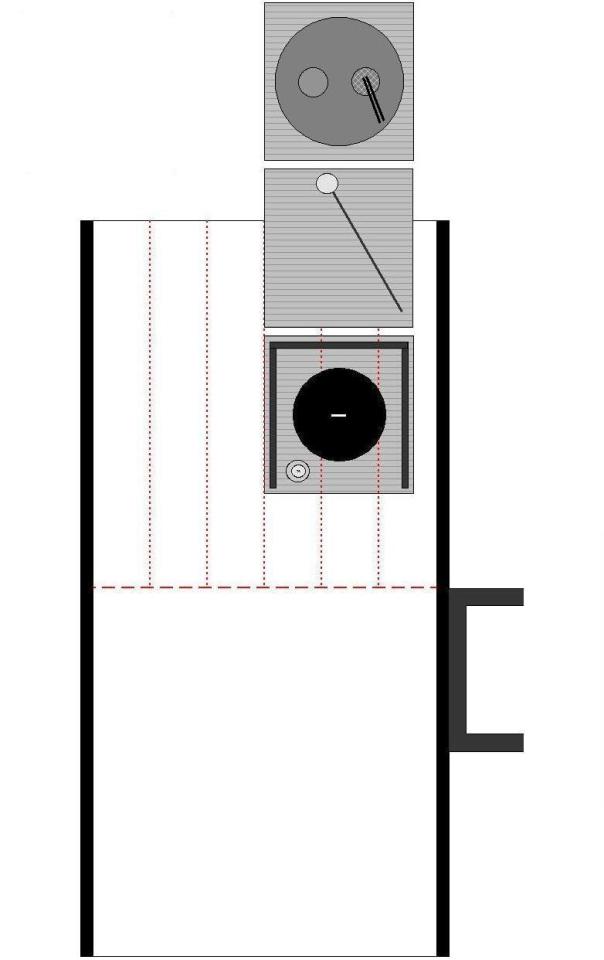
- and the tana had the tray of incense utensils on the ten-ita, the hishaku on the naka-dana, and the mizusashi and futaoki on the ji-ita, making it han [半].
Chō + han + han is chō, which is appropriate for the goza of a gathering that extends into the night. __________ *Though Rikyū did not mention it in the kaiki, a tankei would have been necessary, since he notes that the guests did not return to the tearoom until after it was completely dark.
During the goza, the tankei is placed in the tokonoma, to give light to the room in general. Additional lighting would have been provided by candles, which would be brought out from the katte at the beginning of the temae.
¹⁹Yoru ni iri [夜ニ入].
The guests returned to the room for chanoyu after it became dark. Perhaps they had been sitting in the koshi-kake, watching the sky grow dark and the stars come into focus*, chatting quietly, and perhaps reciting impromptu, seasonal poems. __________ *Tanabata celebrates the once-a-year meeting of the stars Vega (Orihime [織姫], the Weaver) and Altair (Hikoboshi [彦星], the Cowherd). It is said that they can meet only if the sky is clear.
²⁰Toko hanaire tori-irete [床 花入取入テ].
The chabana was removed from the toko during the (prolonged) nakadachi -- since the flowers would not be easy to see after the room became dark (since the source of light would be below and on the left, making the flowers either nearly invisible, or obscured by grotesque shadows).
²¹Tanzaku-bako [短尺箱].
Rikyū has made another clerical error. The word should be tanzaku-bako [短冊箱] -- a box in which a collection of long poetry cards* were kept.

__________ *The cards could be blank (perhaps with paintings hand-sketched on them), or they might have seasonally-appropriate poems written on them. Rikyū's collection, on this occasion, probably included both kinds -- since, after reading the poems and sniffing the incense, the guests might be moved to write their own verses on the blank cards.
²²Ue, bon ni ﹆kōro, usu-gumo kōgō guri-guri, kasane-kyōji [上、盆ニ ﹆香爐、薄雲 香合 クリ〰、重香箸].
This entry, in the Enkaku-ji manuscript, is very confusing -- since Jitsuzan seems to have redistributed the different elements in a way that really does not make any sense.
A tray (Rikyū does not specify what kind, but it was probably 1-shaku across or a little larger) was placed on the ten-ita of the tana, on which were arranged the incense utensils:
◦ Rikyū's ido-kōro [井戸香爐]*;

◦ Rikyū's guri-guri kōgō [ぐりぐり香合], containing the kyara known as Usu-gumo [薄雲] (placed in a small envelope made of gold-foil-backed donsu), and several gin-yō [銀葉]†;

◦ and, apparently, with the pair of ebony kyōji [香箸] either stacked on top of the kōgō, or perhaps stacked one on top of the other (though this would look odd).

“Usu-gumo” [薄雲] was the name of Rikyū's personal variety of treasured kyara [伽羅] incense wood‡. __________ *While Rikyū also seems to have owned (or at least had access to) the famous celadon Chidori kōro [千鳥香爐] that had been one of Jōō's particular treasures, celadon does not look good under artificial illumination. Thus Rikyū's ido-koro (which is a deep beige color) would have looked much better at night.
The kōro is marked with a red spot in the Enkaku-ji manuscript, indicating that it was an object of special consideration (though whether for Rikyū, when organizing the arrangement, or for the delectation of the guests, is not clear).
†Gin-yō [銀葉] are pieces of mica approximately 1-sun square, usually with an applied silver edge. The kyara is placed on the gin-yō to burn. This keeps the ash clean and uncontaminated (the resins in the kyara melt as it is heated), and allows the host to discard the used incense easily (by throwing it away together with the gin-yō to which it is fused).
‡That is, he owned the entire branch or log. Teamen of the period preferred to own the entire piece, if they could afford it, rather than buying a fragment.
In the manuscript consulted by Tanaka Senshō (which was the copy that Tachibana Jitsuzan made with the Shū-un-an documents in front of him), the word Usu-gumo [薄雲] is clearly associated with the word kōgō, not the kōro, and the entry reads as I have described it above. In the Enkaku-ji version, however, “Usu-gumo” appears to be the name of the kōro (though no such piece has ever been identified); and the kōgō, meanwhile, seems to be a jū-kōgō [重香合], which is a set of two or three little boxes that sit one atop the other, in which the kyara incense, new gin-yō, and the discarded gin-yō (with a burned-out piece of kyara fused to each) are kept (the lowest box is lined with metal to prevent the hot gin-yō from damaging the lacquer). While such boxes were known even in the early days, there is no indication that Rikyū ever owned one. Neither has a guri-guri jū-kōgō ever been found.
Precisely why Jitsuzan changed the associations when making the copy that he intended to present to the Enkaku-ji is not known. Probably the easiest explanation is that he copied the original in a hurry, and did not trust his eyes when he came to making the copy -- letting his imagination change things to suit his seventeenth century prejudices.
²³Naka hishaku [中 ヒシヤク].
The hishaku was placed on the naka-dana.
²⁴Shita mizusashi moto no ・ futaoki moto no [下 水指 元ノ ・ 蓋置 元ノ].
And the mizusashi and futaoki remained as they were, on the ji-ita of the tana.
²⁵Chaire ryūgo [茶入 リウコ].
Rikyū has used this chaire several times before in the series of chakai documented in Book Two of the Nampō Roku -- usually on festive occasions -- but scholars are divided regarding the precise piece in question.
Most seem to lean toward a drum-shaped chaire (originally a gift container for medicinal liqueur), in which case the word would be ryūgo [立鼓].

Shibayama Fugen (and those scholars who follow his lead), however, prefers a container that was originally used as a ceremonial wine-cup (this would be especially appropriate, since it, too, was used on festive occasions), called a ryūgo [立觚], and example of which is shown below.
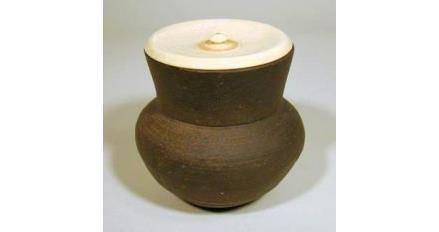
²⁶Chawan Ko-mamori [茶碗 木守].
This was a red chawan made by Chōjirō [長次郎]. Over the course of his life (as documented in his surviving kaiki), Rikyū used this chawan more often than any of the others. So, if any of the bowls can be considered to approach Rikyū’s ideal, this one must come closest.

The original chawan was destroyed during the great earthquake in the early part of the 20th century. What is shown is an Edo period copy, made when the original was still extant.

In addition to the above things, Rikyū would have used an ori-tame [折撓] of his own making as the chashaku. And, most probably, a mentsū [面桶], as the koboshi.

²⁷Cha sugite kō ari [茶過テ香アリ].
After Rikyū finished serving tea, the party turned to the appreciation of kyara [伽羅] incense. In addition to the kind prepared by Rikyū (which he had named “Usu-gumo” [薄雲]), noblemen usually carried a little of their own favorite kyara on their person, which they often shared with the others on occasions such as this.
The guests (and host) would have passed the night sniffing incense and composing poems, to honor the meeting of the stars; and the party probably did not break up until the first light separated the lovers in the heavens for another year.
2 notes
·
View notes
Photo
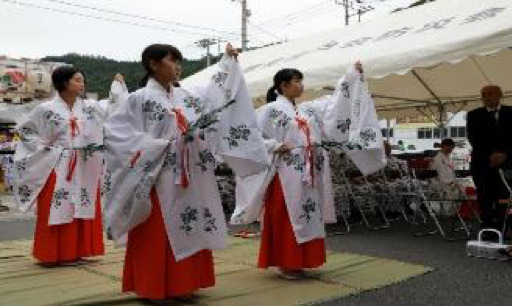
Kagura Dances
Kagura, literally “entertainment for the gods,” is a form of traditional dance tracing its history back to one of Japan’s oldest legends. As the story goes, long ago the sun goddess Amaterasu no Omikami hid herself in a cave to sulk after a dispute with her brother, thus casting the world into darkness. To coax her out from hiding, the goddess Ame no Uzume performed a dance in front of the cave, making the other gods laugh. Amaterasu was intrigued with their laughter and so came out to watch, bringing light back to the world. Kagura developed as an imitation of Ame no Uzume’s dance.
Today a vast number of kagura lineages survive, each with their own unique components. In Tsuru alone there are thirty varieties of dance. Among the best times to witness local kagura is during Oide Shrine’s Hassaku Festival on September 1st. Here, the shrine’s ornately carved kagura float is paraded through the city accompanied by performances of the shrine’s own traditional dances that date back more than 200 years.
※この解説文は観光庁の地域観光資源の多言語解説整備支援事業で作成しました
1 note
·
View note
Text






Energy pilk degustation (they said it tastes great, I almost choked. Almost killed a punishing bird)
#dieci meursault#limbus company cosplay#lobotomy corporation cosplay#ring sang#binah#binah cosplay#meursault cosplay#dieci meursault cosplay#ringsang cosplay#punishing bird#lobotomy corporation#my cosplay#tsuru japan festival
23 notes
·
View notes
Text
Oc Creation: Names
the writing took longer than I expected but I’m done with the first part all thanks goes to ayalaatreides for proofreading and editing.
When naming, its very self explanatory, they have to have at least a number in their name. Since numbers are the central themes, it's no surprise that's what all the characters are named after. There's a heavy use of Japanese mythology and folklore in the series. They have a pattern, it’s fun and easy once you get the hang of it. Let’s begin with the inmate side of naming: the inmates go by aliases instead of their real names, for instance in flashbacks no one referred the characters by their current names. In a post I explained cell 13’s Jyugo,Uno Nico and Rock’s names; as I said before, naming can be fairly easy once you get the hang of it.
Inmates
The inmates’ names are from their id number, but it could also be something deeper. With Jyugo, “Jyugo” is the Japanese number for “15”, his cell number. Uno is Spanish for “one” from the card game, citing his gambling habits and part of his id number “11”. Rock, when pronounced in Japanese, is “Rokku”, “ro” meaning “6”, “kuu” meaning “nine”, together mean “69”. Rock could mean as “strong as a rock”, like his inhuman strength would suggest. In Nico’s name, “ni” means “2” in the Japanese language, and “ko” is the phonetic symbol for “go” meaning “5”. Nico’s name means “second child”, his status being the youngest and most childlike out of all of his cell mates as well as his second personality that comes out later in the series. His name has different meanings attached, which are “smile” and “sunlight”, like his bright and energetic personality.


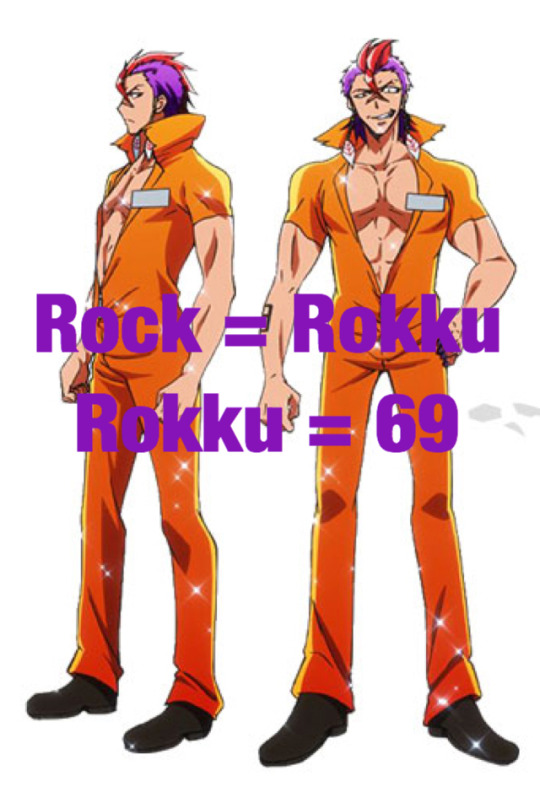
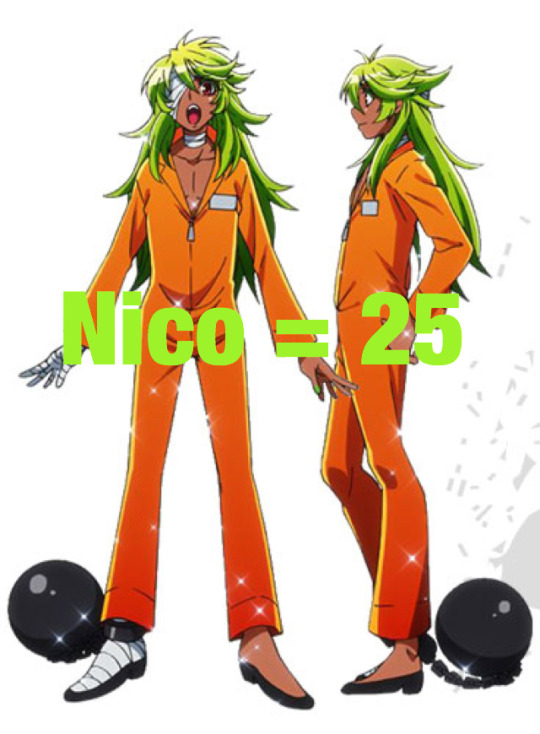
You have to remember. you can count numbers many ways in Japanese, for example Tsukumo’s name means “99” in Japanese. In naming, take apart what's in the name, Rock’s “rokku”, “ro” being “six”, “ku” being “nine”. When it comes to a character’s kanji look at Kusatsu and Fujisan’s names. Kusatsu’s name in kanji is taken from Kusatsu, a town known for its hot springs. “Ku” means “9”, “Sa” means “3”, “Tsu” could mean “2”. Don’t believe me? Look at the kanji. As for Fujisan, it's a play on the term “Fujisan”, another notable hot spring, “fu” comes from “futa” meaning “2”, and “ji” like Nico, “ji” is the phonetic symbol for “shi” meaning “4” and “sa” = “san” meaning “3”, fitting since they both love hot springs so much.
Now time for the inmates from the other buildings. I’ll start with building 3, inmates Trois and Honey., “Trois” is french for “3”, his nationality being french. For Honey, the Japanese pronunciation is “hani”, “ha” from “hachi” meaning “eight”, “ni” being “two” like his cell number. Another american, like Rock whose name is in Japanese pronunciation.
In naming, look at their nationality when naming your inmates. If that's the case, then why is Musashi given a Japanese name instead of a German name? Easy: it's to represent the building he resides in. Building 4’s theme is culture, since it has Japanese culture it’s made to reflect the theme of the building. Musashi's name is broken up into “mu” from “muttsu” meaning “6”, “sa” being “san” meaning “3”, “shi” being “4”, like his inmate id number 634. His name comes from Miyamoto Musashi, the author of the Five Rings, a renowned Japanese swordsmen.
Last but not least: building 5 inmates Upa, Liang and Qi. Their names are reflected in their nationality being Chinese. Liang’s name is Mandarin Chinese for “2”, his cell number. For Qi it’s “seven” like part of his cell number “7” in 71. As for Upa, “pa” is read as “eight” in Chinese. Like Nico, Musashi, and Uno, he has other meanings in his name as well., Upa’s name came from isha upa yoga (a form of yoga) referring to how he first appeared meditating, and also a buddhist monk, Upagupta. Qi’s name came from “Qi”, or “the central underlying principle in Chinese traditional medicine and in Chinese martial arts. The practice of cultivating and balancing qi is called qigong.” This links Liang, Upa and Qi together due to them having martial arts,qigong and medicine in their characters.
Now I’m done with the inmate side of naming; time to move on with the guards. They take another step but it’s lot of fun.
Guards
Let’s start off with the guards of building 13, Hajime Sugoroku. Hajime means “begin”, which is used in traditional martial arts such as karate,judo,aikido and kendo, matching Hajimes speciality in combat where he uses his fists for fighting. The kanji in his name means “one”, him being the number one man in Nanba prison. Sugoroku is a traditional Japanese new year’s board game. For his family, his brother Hitoshi’s name means “benevolence”, showing contrast to Hajime’s short tempered and violent temperament. Hitoshi can be spelled as “hitotsu” in different kanji meaning “one”, showing a connection to Hajime being his family.
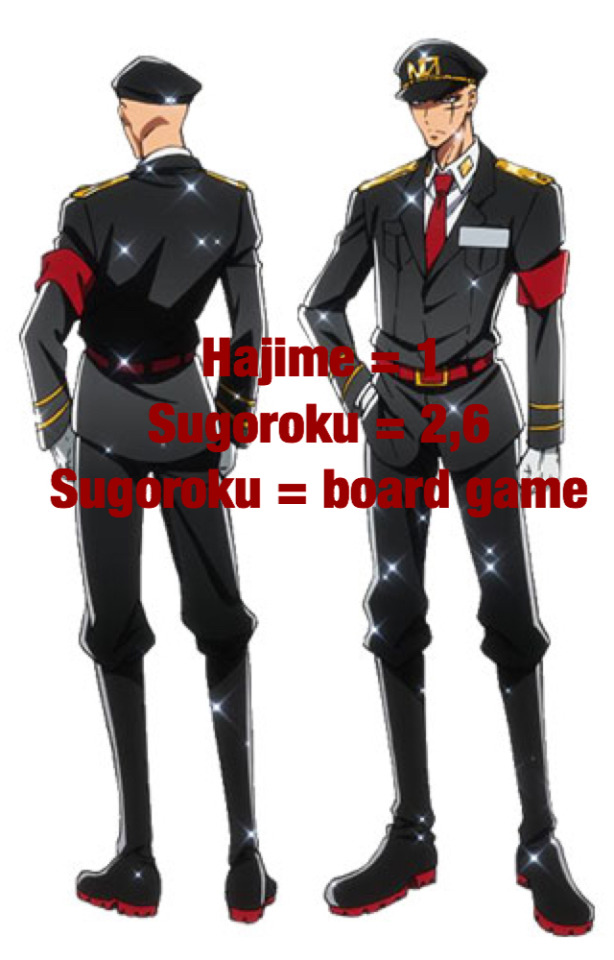
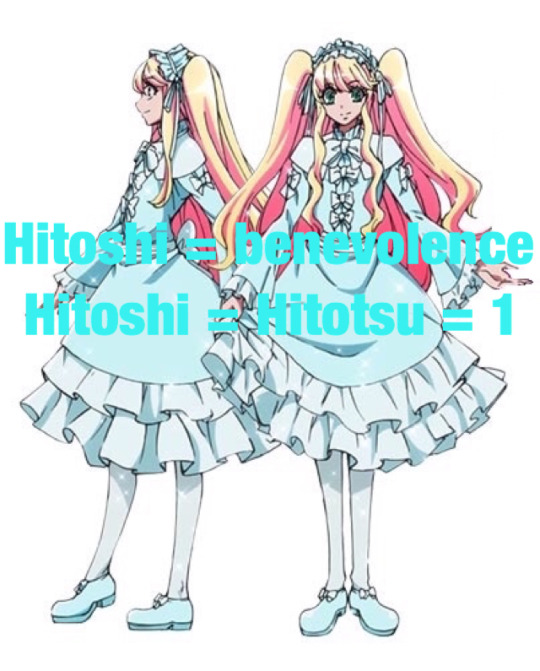
Next is Seitarou Tanabata. His surname comes from the tanabata legend, and Tanabata’s a star festival held in japan. “Sei” means “star”, “tarou” is used for boys in japan and could also mean “eldest son”., Iif you look closely, his name could have a number if you look at “tarou”. Yamato’s name is from a Japanese battleship, and Yamato is an ancient alternative spelling of japan. The kanji of his name Godai means “five great”, named after the japanese elements from Japanese philosophy.
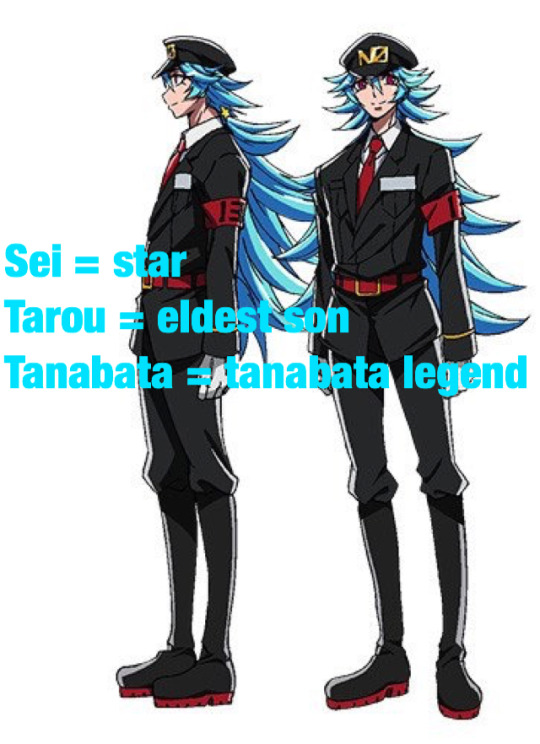
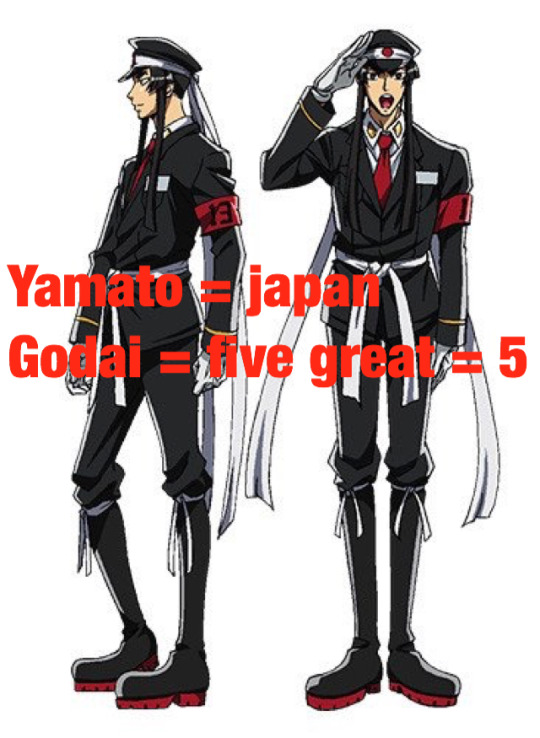
The guards of Nanbaka are named from characters in Japanese folklore and legend, like Momoko Hyakushiki, Samon Goku, Kenshirou Yozakura, Kiji Mitsuba, Mitsuru Hitokoe. Momoko, Samon, Kenshirou and Kiji are an allusion to the legend of Momotaro. Momoko being Momotarou, Samon the monkey, Kenshirou the dog, Kiji the pheasant. For their names, “momo” in her name is another way of saying “a hundred” in Japanese, and “ko” is used for girls in Japan. “Hyaku” means “a thousand”, “shiki” means “command”. As her name suggests she's a commanding presence in Nanba prison and warden of Nanba prison.

Samon is named after a character from the Chinese novel, Journey of the West, the Monkey. “Go” means “5” citing building 5 the building he is supervising.
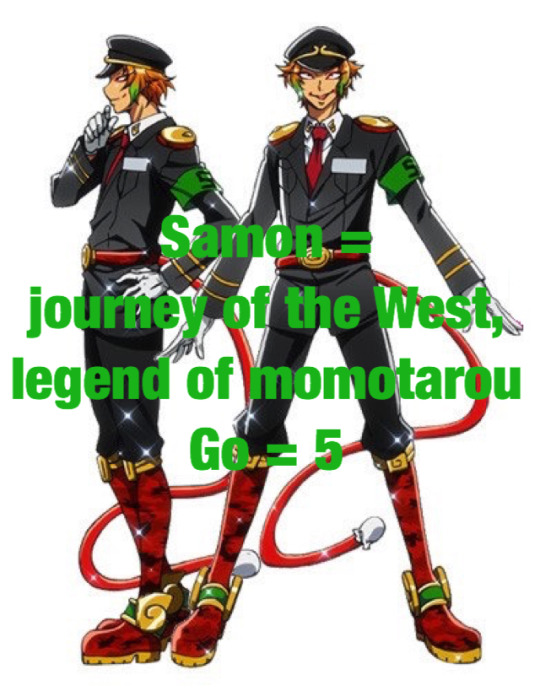
In Kenshirou, “ken” means “dog”, which is his motif in his design, “shi” means “scholarly officer” referring to his intelligent and informed personality, “rou” is a last name usually given to boys in Japan. Yozakura means “four cherry blossoms”. Taken from “yozakura”, an event that takes place after hanami, cherry blossom viewing at night, and “yo” in his surname means “4” referring the building he is supervising.

Kenshirou’s guard dogs of building 4 are named after flowers with numbers., In Japan people use flower language to convey emotions to each other. Since building 4’s theme is culture, it talks about japanese culture which uses hanakotoba (the language of flowers) which is proxy used in japanese culture. The guards are dogs that are different breeds, and they have flowers in their names I = one Ni = two Shi = four “no” is a naming particle using “of” when writing Japanese. Their last name “hana” means “flower” in Japanese. For tThe head guard dog Genrou Byakuya, Genrou’s full name means “mysterious wolf” and “Byakuya” means a “hundred nights”.
Next is Kiji Mitsuba. “Kiji” is Japanese for “pheasant”, “mitsu” is Japanese for “three”, “ba” meaning “leaf”, his surname together means “three leaves”, a japanese parsley which is a vegetable in Asian cultures. “mitsu” means “3”, which refers to his building that he supervises.

The guards of building 5 are named after characters from the Journey of the West novel. Inori’s name means “wild boar”, “nori” meaning “hicklish”, his surname means “eight commandments”, taken from zhu bajie a character from Journey of the West who shares the same personality traits as Inori. Part of Houzuki’s name means “law or buddhist”, referencing his outfit, “zuki” means “moon” and “Hou” is another way of saying “Hōshi” , “gen sanzou”. “Sanzou” is taken from “genjou sanzou”, a Chinese buddhist and the monk from Journey of the West, the wandering priest. For the Daisen brothers’ names, “dai” means “great”, “sen” means “sage”. The brothers are named after some of the characters from the Journey of the West. “Roku” means “6”, “koko” means “9”, “you” means “8”, “riki” at the end means “power”. Rokuriki is named after the immortal of elk power, Youriki after the immortal of antelope power, and Kokoriki the immortal of tiger power, as seen again with their weapons. Ruka’s name means “flow of the river”. “Go” means “5” and “jo” means “pure clean unspoiled”. Ruka’s surname is taken from Sha Wujing, a river ogre from Journey of the West that accompanied Sanzou on his journey. Hachiman is an inmate whose name means “eight thousand”, he's named after a synthetic divinity of archery, and his power hungry nature references this. Also named after Zhu Bajie, the pig, encompassing his violent traits.
For the supervisors of other buildings: for the supervisor from building 1 Tomato Ichijou, “to” means “rabbit”, and in his kanji “ma” means “ten thousand”; “ichi” means “one” and “jou” means “streak”. “Ichi” in his name references the building he supervises. Nijimasu Nanairo means “seven colors”, his whole name together means “7 colored rainbow”. “Nana” meaning “7”, the building he’s supervising. For Mao, a deputy supervisor, his name “mao” literally means “cat” in Chinese; his surname “ni” means “2”, “ji” means “dance”, “ma” means “under”, and “2” in his surname references the building he is working in. Mao is based on the nekomata, a cat demon with 2 tails for being from building 2. Also a reference to it his love for money, a reference to another legend, the legend of maneki neko which is seen holding a coin.
To the staff: for Mitsuru Hitokoe, “mitsu” means “3”, “tsuru” means “crane”, “hito” means “one”, “koe” means “voice”. Mitsuru is taken from the folklore “Tsusru no Ongaeshi, the crane returns the favor”. The doctor’s name “okina” means “old man”, “o” means “drive or manage”, “to” means “ten”, “gi” means “justice, righteous”. His name’s taken from “Taketori no Okina”, the adoptive father of Kaguya Hime from The Tale of Princess Kaguya.
Kazari means “to decorate”, and Kagu 8 is an allusion to Princess Kaguya who was adopted by okina, and had many suitors wooed by her beauty. “Kagu” means “god,diety”, and “8” is another way of saying “ya”, the number 8 in Japanese.
So when naming your characters, look at the pattern from their names and how they are arranged closely: they have numbers like the title suggests.
Inmates Jyugo = 15 Uno = 11 Rock = 6,9 Nico = 2,5 Tsukumo = 99 Fujisan = 2,4,3 Kusatsu = 9,3,2 Trois = 3 Honey = 8,2 Liang = 2 Qi = 7 Upa = ba = 8 Musashi = 6,3,4
Guards For guards, they have numbers and are based on folklore
Hajime Ssugoroku = 1,2,6 Yamato Godai = 5 = Japanese battleship Yamato Seitarou Tanabata = 1 = Tanabata legend Okina Otogi = 10 = the Legend of Princess Kaguya Kazari Otogi = 10 = the Legend of Princess Kaguya Kagu 8 = 8 = the Legend of Princess Kaguya
Momoko Hyakushiki = 100,100 = Llgend of Momotaoru Samon Goku = 3,5,9 = Legend of Momotaoru = Journey of the West Kenshirou Yozakura = 4 = Legend of Momotaoru Kiji Mitsuba = 3 = Legend of Momotaoru Mitsuru Hitokoe = 3,1 = The Crane Returns the Favor
Mao Nimaijita = 2 = Nekomata,Maneki-neko
Tomato Ichijou = 10,000,1 Nijimasu Nanairo = 7
Inori Hakkai = 8 = Journey of the West Houzuki Sanzou = 3 = Journey of the West Ruka Gojo = 5 = Journey of the West Kokoriki Daisen = 9 = Journey of the West Youriki Daisen = 8 = Journey of the West Rokuriki Daisen = 6 = Journey of the West Hachimen = 8,10,000 = Journey of the West
47 notes
·
View notes
Text
Aviation Club Manga Blue Thermal Takes Flight as Anime Film in 2022

Next year, Kana Ozawa's manga about unpowered flight takes to the skies with an animated film adaptation!
Blue Thermal -Aonagi College Sports Festival Aviation Club- began its run in 2015 in Monthly Comic @Bunch, finishing its run in the course of five volumes. The series focuses on the world of gliding: flight in unpowered planes ("gliders" or "sailplanes") that stay airborne on currents of rising air in the atmosphere.
A key visual, teaser trailer, and cast list were all put out today:

Actress and model Mayu Hotta, who recently appeared as Ai Hayasaka in the live-action KAGUYA-SAMA: LOVE IS WAR, will voice main character Tamaki Tsuru:

Nobunaga Shimazaki (Ritsuka Fujimaru in Fate/Grand Order) voices Jun Kuramochi:

And Junya Enoki (Nasa Yuzaki in TONIKAWA: Over the Moon for You) plays Daisuke Sorachi:

Check out the teaser trailer for a first look:
youtube
The film is directed by Princess Principal director Masaki Tachibana, from a script by Tachibana and Farewell, My Dear Cramer screenplay writer Natsuko Takahashi. It is produced by Telecom Animation Film and "Blue Thermal" Production Committee, and will be released by Toei.
Blue Thermal is due for release in Japan in March 2022.
Source: Anime! Anime!


By: Kara Dennison
1 note
·
View note
Text
Japanese Symbolic Animals.
Butterflies - Choho.
Japan perceives the butterfly to be a ‘soul of the living and the dead’, as a result of the popular belief that spirits of the dead take the form of a butterfly when on their journey to the other world and eternal life. The butterfly is also often used as a symbol for young girls as they spread their wings and emerge into womanhood, as well as it being believed to symbolise joy and longevity. Additionally, if a symbol contains two butterflies dancing around each other, it’s a symbol of marital happiness.

Koi Carp.
Koi’ means ‘Carp’ in Japanese, and this fish is a symbol of perseverance due to the fish’s tendency to swim upstream and resist the flow of water. Koi Carp also symbolise faithfulness and marriage in Japan. A design of carp swimming against rapids symbolises the Children’s Day Festival on May 5th. This is to inspire children to work hard in order to succeed.

Cranes - Tsuru.
The crane represents good fortune and longevity. As a one of the Japanese folklore animals, the symbolism behind these animals comes from the folklores themselves, as it was believed that the crane lives for 1,000 years. The crane is also closely associated with Japanese New Year and wedding ceremonies due to cranes being monogamous. Because of this, the image of a crane is sometimes woven into beautiful wedding kimonos.

Frogs - kaeru.
Among popular Japanese spiritual symbols are frogs. There are many species of frogs in Japan as a result of flooding rice fields in Japanese agriculture. These creatures are often used in poetry and art, and are sometimes carried by travellers to make sure they return home safely from their journeys. The word ‘frog’ in Japanese means ‘return’, which is why the frog is considered a Japanese lucky animal and seen as good fortune in things returning.

Turtles - Kame.
The Japanese word for turtle is kame, and the Japanese believe that the turtle is a symbol for wisdom, luck, protection, and longevity; longevity due to their long lifespan and slow movements. The turtle is magic and unites heaven and earth, with its shell representing heaven and its square underside representing earth.

- helping me find an animal to use make my Yuru-Chara, by seeing what Japanese animals represent.
0 notes
Text
[News] Tsuru Japan Festival 2019 tuż tuż!

Do rozpoczęcia Tsuru Japan Festival 2019 zostało już niecałe półtora tygodnia! Ekipa zebrana? Cosplaye skończone? Atrakcje przygotowane? Pieniądze na koncie? Jeśli nie, bez paniki, wciąż jest jeszcze trochę czasu!
Od czasu naszego ostatniego wpisu organizatorzy nie próżnowali! Liczba gości znacząco się zwiększyła, jest ich już tylu, że została przygotowana specjalna podstrona na zebranie informacji o wszystkich personach: https://tsuru.com.pl/goscie
Szczególnie ucieszą się cosplayerzy, ponieważ to właśnie dla nich zostały przygotowane atrakcje na bardzo wysokim poziomie! Konwent odwiedzą znane twarze, które poprowadzą atrakcje tematyczne dla uczestników. Konkurs natomiast, będą oceniać postaci znane i utytułowane na arenie międzynarodowej - Asgardian Fraud, Vanthica's Cosplay Ventures oraz Crafts of Two! Co więcej, dla wszystkich przebierańców udostępnione zostanie fotostudio, w którym zdjęcia robić będzie nie kto inny jak Studio Zahora. Czuję, że będą kolejki do fotostudia!
Oprócz cosplayerów, na Tsuru zawita Piotr Milewski - autor książek między innymi o Japonii, które wielu uczestników na pewno zna, a dla innych będą pozycjami godnymi polecenia. W Rybniku pojawi się również aktor głosowy Karol Gajos, którego można kojarzyć z roli Son Gohana z Dragon Ball Super! Jeśli ktoś chce więcej gości - nie ma problemu! Do wyżej wymienionego grona dołączy również gromadka vlogerów i artystów znanych i lubianych prosto z YouTube.
Organizator nie powiedział jeszcze ostatniego słowa i dosłownie codziennie udostępnia coraz to nowe informacje o kolejnych ekipach medialnych, stoiskami z jedzeniem, atrakcjami dla uczestników… Wszyscy czekamy na ogłoszenie ramowego planu imprezy, aby móc zacząć planować atrakcje, na jakie chcemy się wybrać (jak tylko plan się pojawi, udostępnimy go na naszej grupie!).
Jeśli chodzi o atrakcje Gintamowe, to sytuacja wygląda dokładnie tak samo, jak ostatnio - żadnych paneli! Niemniej, parę osób z redakcji Gintama Polska będzie kręcić się po conplace! Dobra okazja do przybicia piątki! Dodatkowo wrony kraczą, że na konkursie cosplay pojawi się strój z Gintamy. Ciekawe, kto to może być…
Do zobaczenia 23 listopada w Rybniku!
#tsuru#tsuru japan festival#tsuru2019#gintama#gintama-polska#crafts of two#asgardian fraud#vanthica#konwent#news
1 note
·
View note
Photo
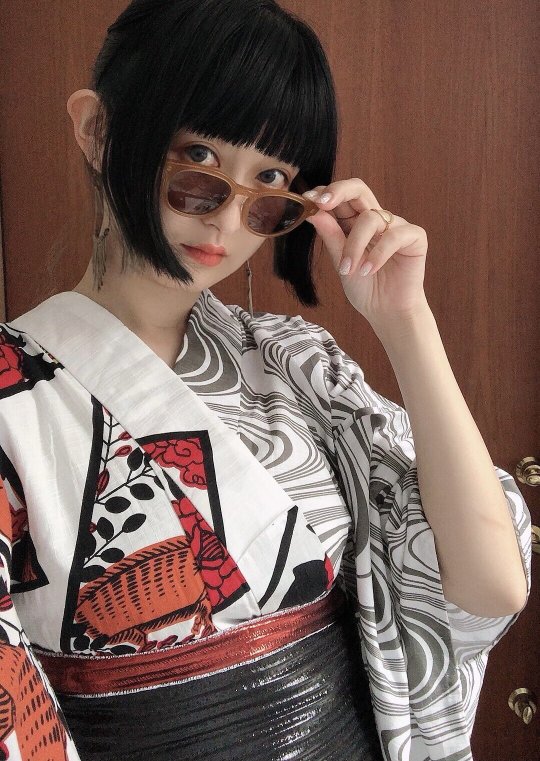
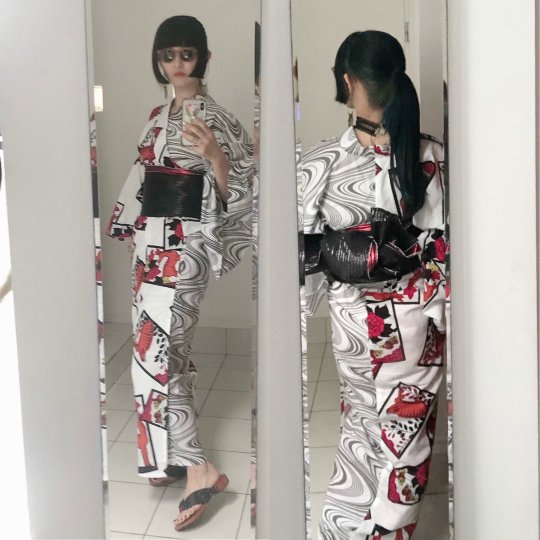
Super cool hanafuda (”flower cards”) + ryuusui (stream) yukata (seen on), paired with a Rumirock obi.
I believe I’ve never touched Hanafuda cards here, so buckle up for a long post ;)

Hanafuda is a card game with 12 different suits of 4 cards. Each suit is linked to a lunar month through symbols, all inspired by classical culture (months where later matched to Western calendar hence why some symbols seem off).
Please note that in the list below, I’ll use ‘meaning’ in the broad sense as following symbols often have many overlaping significations:
睦月 Mutsuki (1st lunar month) / January => Symbols: matsu (pine), tsuru (crane), hi (sun), ‘akayoroshi’ tanzaku (paper strip, with auspicious あ(か)よろし meaning lit. ‘red is good’ = ‘really wonderful’) => Meaning: eternity, happy/new beginnings as January is the New year month

如月 Kisaragi (2nd lunar month) / February => Symbols: ume (plum blossoms), uguisu (bush warbler), ‘akayoroshi’ tanzaku (paper strip, with auspicious あ(か)よろし lit. ‘red is good’ = ‘really wonderful’) => Meaning: beginning of spring, well read people (especially refers to Michizane/Tenjin), a match made in heaven As a side note, plum branches rising to the sky is an auspicious motif known as yariume/“spear plums” or tachibai/“rising plums
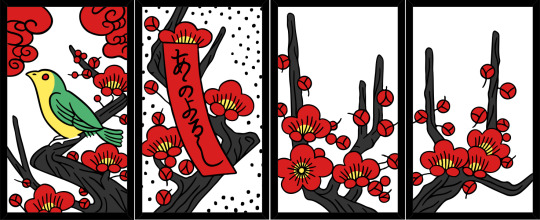
弥生 Yayoi (3rd lunar month) / March => Symbols: sakura (cherry blossoms), hanamimaku (curtain, here cherry blossoms viewing parties), ‘Miyoshino” tanzaku (paper strip, Yoshino is a place famous for its sakura) => Meaning: beautiful yet fleeting life (like the delicate sakura blossoms)

卯月 Uzuki (4th lunar month) / April => Symbols: fuji (wisteria), hototogisu (cuckoo), red tanzaku (paper strip) => Meaning: coming of summer, beautiful yet fleeting life (cuckoo sometimes symbolize mourning souls). Fuji could also refers to famous episodes of the Tale of Genji. As a side note, cuckoo also stands for patience in Japan, probably because of the zen charade known as “If the bird doesn’t sing..”
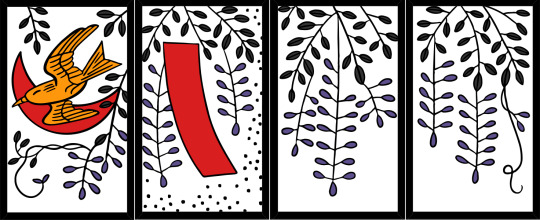
皐月Satsuki (5th lunar month) / May => Symbols: kakitsubata (iris), yatsuhashi (zigzag bridge), red tanzaku (paper strip) => Meaning: deep and nostalgic love, inspired by famous poetical scenery from the Tales of Ise (motif is present in many paintings like this screen by Korin). Iris are also a symbol of strenght as seen in Tango no sekku festival
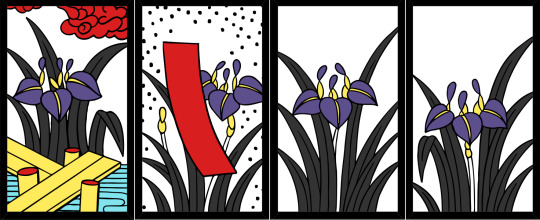
水無月 Minazuki (6th lunar month) / June => Symbols: botan (peony), cho (butterfly), purple tanzaku (paper strip) => Meaning: road to heaven (symbols came be found in noh piece ‘Shakkyo’ and Kabuki one ‘Kagamijishi’), butterflies often stand as a symbol for spirits or souls

文月 Fumizuki (7th lunar month) / July => Symbols: hagi (clover), shishi/inoshishi (boar), red tanzaku (paper strip) => Meaning: coming of autumn, the strong needing the meek (a variation of tiger in the bamboo grove motif)
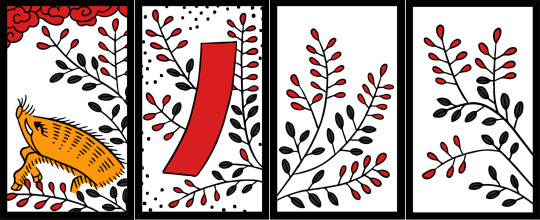
葉月 Hazuki (8th lunar month) / August => Symbols: susuki (pampa grass), kari (wild geese), full moon (meigestu) => Meaning: moon/harvest festival (tsukimi), deep nostalgia as year goes by (nature will soon be asleep as winter will follow autumn)

長月 Nagatsuki (9th lunar month) / September => Symbols: kiku (chrysanthemum), sakazuki (sake cup, with kotobuki/‘long life’ kanji), purple tanzaku (paper strip) => Meaning: long life, immortality. In ancient japan, it was customary to drink chrysanthmum wine during Chouyou no en festival as a wish for long life (people also used to drink/use as medicine dew collected on mums leaves and flowers). As a side note, objets flowing in a stream (like sake cups) were once used as timer during poetry competitions.
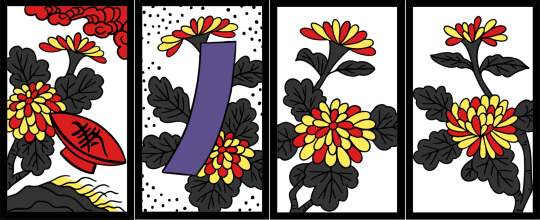
神無月 Kannazuki (10th lunar month) / October => Symbols: momiji (maple), shika (deer) => Meaning: momijigari (hanami autumn twin) parties and as March card = beautiful yet fleeting life. Shika deers also have deep auspicious connotation as they are messengers of the gods in Shinto
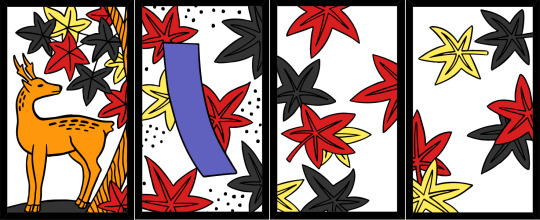
霜月 Shimotsuki (11th lunar month) / November => Symbols: yanagi (willow), Ono no Michikaze and a frog, tsubame (swallow), Inazuma (thunder, wildcard sometimes bare and nicknamed “onifuda”/demon card) => Meaning: this card is always the most puzzling one for me, as in kimono fashion yanagi+tsubame are not truly a November motifs ^^; But here, the most important symbol (most often only present as an umbrella!) is a driving rain under which willows dance. Poet Ono no Michikaze, walking by a riverside in that awful weather, spots a struggling frog. After many efforts, the frog finally succeeds jumping in a willow - inspiring Michikaze. This suits hence symbolizes diligence and determination. As a side note, nure tsubame (lit. “wet sparrows”) symbolize lovers - especially star-crossed ones
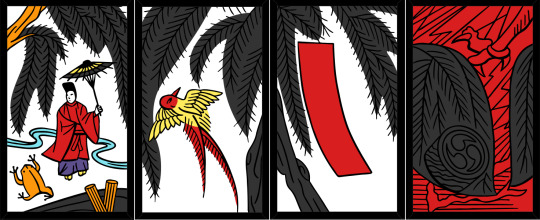
師走 Shiwasu (12th lunar month) / December => Symbols: kiri (paulownia), houou (phoenix) => Meaning: longevity, life circle (“beginning to the end”), power. Legends say phoenix can only nest in paulownia trees

I won’t go into details as to how to play with hanafuda as 1) I am terrible with cards games, and 2) I learned koi-koi rules only thanks to the Ryu ga gotoku/Yakuza video games xD (amazing game serie, if you don’t know about them, go play!!! They have been re-released not long ago)
#japan#fashion#kimono#yukata#hanafuda#card game#cards#lunar month#matsu#tsuru#akayoroshi#tanzaku#uguisu#ume#yariume#tachibai#maku#hanamimaku#Yoshino#sakura#fuji#hototogisu#kakitsubata#ayame#Korin#botan#cho#Shakkyo#Kagamijishi#hagi
1K notes
·
View notes



